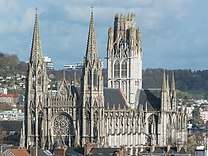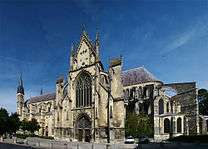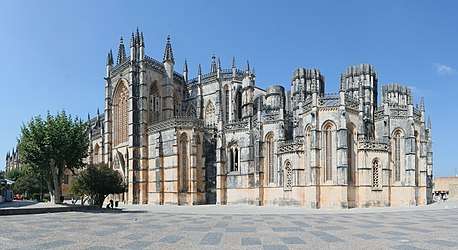Gothic architecture
Gothic architecture (or pointed architecture) is an architectural style that flourished in Europe during the High and Late Middle Ages.[1] It evolved from Romanesque architecture and was succeeded by Renaissance architecture. It originated in 12th century northern France and England as a development of Norman architecture.[2] Its popularity lasted into the 16th century, before which the style was known as Latin: opus Francigenum, lit. 'French work'; the term Gothic was first applied during the later Renaissance.
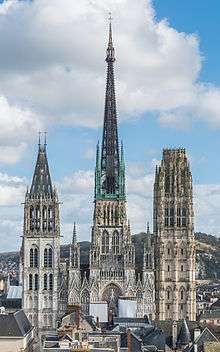 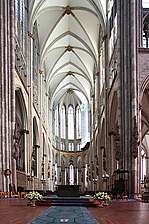 _08.jpg) 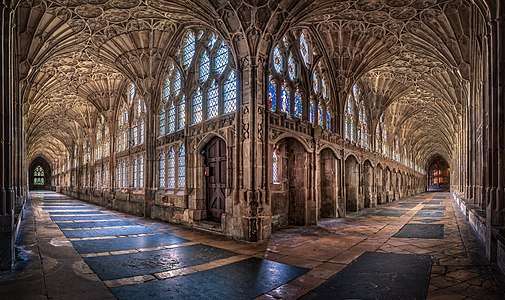 Top: Basilica of Saint-Denis, Rouen Cathedral: Centre: Cologne Cathedral, Chartres Cathedral; Bottom: Gloucester Cathedral | |
| Years active | 12th–17th centuries |
|---|---|
| Influenced | Gothic Revival architecture |
The defining element of Gothic architecture is the pointed or ogival arch. It is the primary engineering innovation and the characteristic design component. The use of the pointed arch in turn led to the development of the pointed rib vault and flying buttresses, combined with elaborate tracery and stained glass windows.[3] These elements together formed a structurally and aesthetically integrated system, or style, that characterises the Gothic.[4]
At the Abbey of Saint-Denis, near Paris, the choir was reconstructed between 1140 and 1144, drawing together for the first time the developing Gothic architectural features. In doing so, a new architectural style emerged that internally emphasised verticality in the structural members, and the effect created by the transmission of light through stained glass windows.[5]
Survivals of medieval Gothic architecture are most common as Christian ecclesiastical architecture, in the cathedrals, abbeys, and parish churches of Europe. It is also the architecture of many castles, palaces, town halls, guildhalls, universities and, less prominently today, private dwellings. Many of the finest examples of mediaeval Gothic architecture are listed with UNESCO as World Heritage Sites.
With the development of Renaissance architecture in Italy during the mid 15th century, the Gothic style was supplanted by the new style, but in some regions, notably England, Gothic continued to flourish and develop into the 16th century. A series of Gothic revivals began in mid-18th century England, spread through 19th century Europe and continued, largely for ecclesiastical and university structures, into the 20th century.
Name
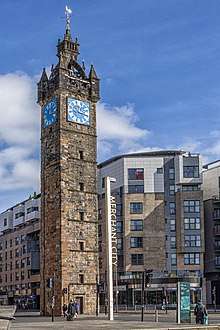
Gothic architecture is also known as pointed architecture or ogival architecture.[6][7] Mediaeval contemporaries described the style as Latin: opus Francigenum, lit. 'French work' or 'Frankish work', as opus modernum, 'modern work', novum opus, 'new work', or as Italian: maniera tedesca, lit. 'German style'.[8][9]
The term "Gothic architecture" originated as a pejorative description. Giorgio Vasari used the term "barbarous German style" in his Lives of the Artists to describe what is now considered the Gothic style,[10] and in the introduction to the Lives he attributes various architectural features to the Goths, whom he held responsible for destroying the ancient buildings after they conquered Rome, and erecting new ones in this style.[11] When Vasari wrote, Italy had experienced a century of building in the Vitruvian architectural vocabulary of classical orders revived in the Renaissance and seen as evidence of a new Golden Age of learning and refinement. Vasari was echoed in the 16th century by François Rabelais, who referred to Goths and Ostrogoths (Gotz and Ostrogotz).[lower-alpha 1][12]
The polymath architect Christopher Wren was disapproving of the name Gothic for pointed architecture. He compared it with Islamic architecture, which he called the 'Saracen style', pointing out that the pointed arch's sophistication was not owed to the Goths but to the Islamic Golden Age. He wrote:[13]
This we now call the Gothic manner of architecture (so the Italians called what was not after the Roman style) though the Goths were rather destroyers than builders; I think it should with more reason be called the Saracen style, for these people wanted neither arts nor learning: and after we in the west lost both, we borrowed again from them, out of their Arabic books, what they with great diligence had translated from the Greeks
— Christopher Wren, Report on St Paul's
According to a 19th-century correspondent in the London journal Notes and Queries, Gothic was a derisive misnomer; the pointed arcs and architecture of the later Middle Ages was quite different to the rounded arches prevalent in late antiquity and the period of the Ostrogothic Kingdom in Italy:
There can be no doubt that the term 'Gothic' as applied to pointed styles of ecclesiastical architecture was used at first contemptuously, and in derision, by those who were ambitious to imitate and revive the Grecian orders of architecture, after the revival of classical literature. But, without citing many authorities, such as Christopher Wren, and others, who lent their aid in depreciating the old mediaeval style, which they termed Gothic, as synonymous with every thing that was barbarous and rude, it may be sufficient to refer to the celebrated Treatise of Sir Henry Wotton, entitled The Elements of Architecture, ... printed in London so early as 1624. ... But it was a strange misapplication of the term to use it for the pointed style, in contradistinction to the circular, formerly called Saxon, now Norman, Romanesque, &c. These latter styles, like Lombardic, Italian, and the Byzantine, of course belong more to the Gothic period than the light and elegant structures of the pointed order which succeeded them.[14]
Periods
Architecture "became a leading form of artistic expression during the late Middle Ages".[2] Gothic architecture began in the earlier 12th century in northwest France and England and spread throughout Latin Europe in the 13th century; by 1300, a first "international style" of Gothic had developed, with common design features and formal language. A second "international style" emerged by 1400, alongside innovations in England and central Europe that produced both the perpendicular and flamboyant varieties. Typically, these typologies are identified as:[2]
- c.1130–c.1240 Early to High Gothic and Early English
- c.1240–c.1350 Rayonnant and Decorated Style
- c.1350–c.1500 Late Gothic: flamboyant and perpendicular
 Abbey church of Saint-Denis, west façade
Abbey church of Saint-Denis, west façade Nave of Sens Cathedral (1135-1176)
Nave of Sens Cathedral (1135-1176)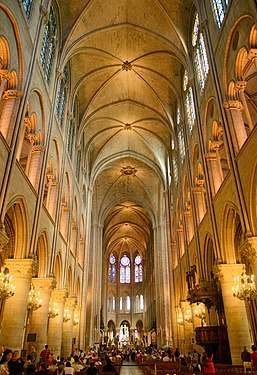 Nave of Notre-Dame de Paris (1163-1345)
Nave of Notre-Dame de Paris (1163-1345)
History
Early Gothic
.jpg)
Sens Cathedral

Norman architecture on either side of the English Channel developed in parallel towards Early Gothic.[2] Gothic features, such as the rib vault, had appeared in England and Normandy in the 11th century.[2] Rib-vaults were employed in the cathedral at Durham (1093–)[2] and in Lessay Abbey in Normandy (1098).[15] However, the first buildings to be considered fully Gothic are the royal funerary abbey of the French kings, the Abbey of Saint-Denis (1134–44), and the archiepiscopal cathedral at Sens (1143–63) They were the first buildings to systematically combine rib vaulting, buttresses, and pointed arches.[2] Most of the characteristics of later Early English were already present in the lower chevet of Saint-Denis.[1]
Saint-Denis was the work of the Abbot Suger, a close adviser of Kings Louis VI and Louis VII. Suger reconstructed portions of the old Romanesque church with rib vault to make the walls thinner, and to bring in greater light through the new stained glass windows he put into place.[16]
The first cathedral in France built entirely in the new style was Sens Cathedral, begun between 1135 and 1140 and consecrated in 1160.[17][18] One of the builders who is believed to have worked there, William of Sens, later travelled to England and became the architect who, between 1175 and 1180, reconstructed the choir of Canterbury Cathedral in the new Gothic style.[17]
Sens Cathedral was influential in its strongly vertical appearance and in its three-part elevation, typical of subsequent Gothic buildings, with a clerestory at the top supported by a triforium, (not a gallery as in earlier buildings, except in England) all carried on high arcades of pointed arches.[19] In the following decades flying buttresses began to be used, allowing the construction of lighter, higher walls.[19] French Gothic churches were heavily influenced both by the ambulatory and side-chapels around the choir at Saint-Denis, and by the paired towers and triple doors on the western façade.[19]
Sens was quickly followed by Senlis Cathedral (begun 1160), and Notre-Dame de Paris (begun 1160). Their builders abandoned the traditional plans and introduced the new Gothic elements. The builders of Notre-Dame went further by introducing the flying buttress, heavy columns of support outside the walls connected by arches to the walls, which received and counterbalanced the thrust from the rib vaults of the roof. This allowed the builders to construct higher walls and larger windows.[20]
The Duchy of Normandy, part of the Angevin Empire until the 13th century, developed its own version of Gothic. One of these was the Norman chevet, a small apse or chapel attached to the choir at the east end of the church, which typically had a half-dome. The lantern tower was another common feature in Norman Gothic.[15] One example of early Norman Gothic is Bayeux Cathedral (1060–70) where the Romanesque cathedral nave and choir were rebuilt into the Gothic style. Lisieux Cathedral was begun in 1170.[21] Rouen Cathedral (begun 1185) was rebuilt from Romanesque to Gothic with distinct Norman features, including a lantern tower, deeply moulded decoration, and high pointed arcades.[22] Coutances Cathedral was remade into Gothic beginning about 1220. Its most distinctive feature is the octagonal lantern on the crossing of the transept, decorated with ornamental ribs, and surrounded by sixteen bays and sixteen lancet windows.[21]

Metz Cathedral

Flamboyant Gothic tower (left)
Chartres Cathedral
High Gothic and Early English
The Gothic style also appeared very early in England, carried by the Normans. The monk-historian William of Malmesbury wrote at the beginning of the 12th century, "you can see everywhere, in the churches in the cities and the monasteries in the villages and towns, being built a new type of construction and flourishing in a new modern style."[23] Durham Cathedral was the first cathedral to employ the rib vault, between 1093 and 1104.[24]
After working on the early Gothic cathedral at Sens, the French master-builder William of Sens travelled to Canterbury to begin in 1175 a new Gothic choir for the archiepiscopal cathedral there.[19] Before the work was finished, he was badly injured by a fall from the scaffolding at Canterbury, and had to return to France, where he died.[25][26] William the Englishman replaced his French namesake in 1178; his tenure as architect of Canterbury Cathedral was marked by the emergence of Early English Gothic.[19] The cathedral churches of Worcester (1175–), Wells (c.1180–), Lincoln (1192–), and Salisbury (1220–) are all, with Canterbury, major examples.[19] Tiercerons – decorative vaulting ribs – seem first to be have been used in vaulting at Lincoln Cathedral, installed c.1200.[19]
The cathedral of Chartres (1194–) was the first High Gothic cathedral, followed by those of Rheims (1210–), Amiens (1220–), and Beauvais (1225–).[19] Here, the whole surface of the clerestory was given over to windows; at Chartres plate tracery was employed, at Rheims Cathedral the bar-tracery was free-standing.[19] Lancet windows were supplanted by multiple lights separated by geometrical bar-tracery.[6] Tracery of this kind distinguishes Middle Pointed style from the simpler First Pointed.[6] Inside, the nave was divided into by regular bays, each covered by a quadripartite rib vaults.[19]
In central Europe, the High Gothic style appeared in the Holy Roman Empire, first at Toul (1220–), whose Romanesque cathedral was rebuilt in the style of Rhiems Cathedral, then Trier's Liebfrauenkirche parish church (1228–), and then throughout the Reich, beginning with the Elisabethkirche at Marburg (1235–) and the cathedral at Metz (c.1235–).[19]
Churches competed in height, with increasingly ambitious structures lifting the vault yet higher. Chartres Cathedral's 36 m was exceeded by Beauvais Cathedral's 48 m, but on account of the latter's collapse in 1248, no further attempt was made to build higher.[19]
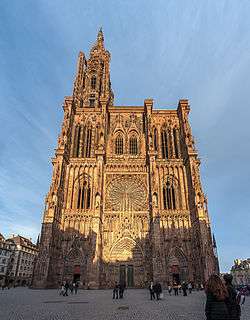
Strasbourg Cathedral (1276–)
Rayonnant Gothic and Decorated Style
Rayonnant Gothic maximised the coverage of stained glass windows such that the walls are effectively entirely glazed; notable examples are the nave at Saint-Denis (1231–) and the palatine chapel on the Île de la Cité in the Seine – the Sainte-Chapelle (c.1241–8).[19] The high and thin walls of French Rayonnant Gothic allowed by the flying buttresses enabled increasingly ambitious expanses of glass and decorated tracery, reinforced with ironwork.[19] This first 'international style' was reflected in the clerestory of Metz Cathedral (c.1245–), then Cologne's cathedral (c.1250–), and again in the nave of the cathedral at Strasbourg (c.1250–).[19] Masons elaborated a series of tracery patterns for windows – from the basic geometrical to the reticulated and the curvilinear - which had superseded the lancet window.[6] Bar-tracery of the curvilinear, flowing, and reticulated types distinguish Second Pointed style.[6]
Decorated Gothic similarly sought to emphasise the windows, but excelled in the ornamentation of their tracery. Churches with features of this style include Westminster Abbey (1245–), the cathedrals at Lichfield (after 1257–) and Exeter (1275–), Bath Abbey (1298–), and the retro choir at Wells Cathedral (c.1320–).[19]
The Rayonnant developed its second 'international style' with increasingly autonomous and sharp-edged tracery mouldings apparent in the cathedral at Clermont-Ferrand (1248–), the papal collegiate church at Troyes, Saint-Urbain (1262–), and the west façade of Strasbourg Cathedral (1276–).[19] By 1300, there were examples influenced by Strasbourg in the cathedrals of Limoges (1273–), Regensburg (c.1275–), and in the cathedral nave at York (1292–).[19]
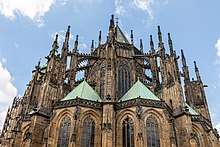
Prague Cathedral (1344–)
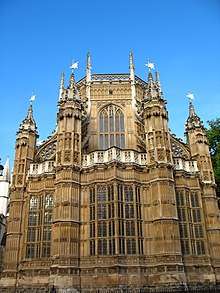
Late Gothic: flamboyant and perpendicular
Central Europe began to lead the emergence of a new, international flamboyant style with the construction of a new cathedral at Prague (1344–) under the direction of Peter Parler.[19] This model of rich and variegated tracery and intricate reticulated rib-vaulting was definitive in the Late Gothic of continental Europe, emulated not only by the collegiate churches and cathedrals, but by urban parish churches which rivalled them in size and magnificence.[19] The minster at Ulm and other parish churches like the Heilig-Kreuz-Münster at Schwäbisch Gmünd (c.1320–), St Barbara's Church at Kutná Hora (1389–), and the Heilig-Geist-Kirche (1407–) and St Martin's Church (c.1385–) in Landshut are typical.[19] Use of ogees was especially common.[6]
The flamboyant style was characterised by the multiplication of the ribs of the vaults, with new purely decorative ribs, called tiercons and liernes, and additional diagonal ribs. One common ornament of flamboyant in France is the arc-en-accolade, an arch over a window topped by a pinnace with a fleuron, and flanked by pointed pinnacles. Notable examples of French flamboyant building include the west façade of Rouen Cathedral, and especially the façades of Sainte-Chapelle de Vincennes (1370s) and choir Mont-Saint-Michel's abbey church (1448).[20]
In England, ornamental rib-vaulting and tracery of Decorated Gothic co-existed with, and then gave way to, the perpendicular style from the 1320s, with straightened, orthogonal tracery topped with fan-vaulting.[6][19] Perpendicular Gothic was unknown in continental Europe and unlike earlier styles had no equivalent in Scotland or Ireland.[6][27] It first appeared in the cloisters and chapter-house (c. 1332) of Old St Paul's Cathedral in London by William de Ramsey.[27] The chancel of Gloucester Cathedral (c. 1337–57) and its latter 14th century cloisters are early examples.[27] Four-centred arches were often used, and lierne vaults seen in early buildings were developed into fan vaults, first at the latter 14th century chapter-house of Hereford Cathedral (demolished 1769) and cloisters at Gloucester, and then at Reginald Ely's King's College Chapel, Cambridge (1446–1461) and the brothers William and Robert Vertue's Henry VII Chapel (c. 1503–12) at Westminster Abbey.[27][28][29] Perpendicular is sometimes called Third Pointed and was employed over three centuries; the fan-vaulted staircase at Christ Church, Oxford built around 1640.[6][27]
Lacey patterns of tracery continued to characterise continental Gothic building, with very elaborate and articulated vaulting, as at St Barbara's, Kutná Hora (1512).[6] In certain areas, Gothic architecture continued to be employed until the 17th and 18th centuries, especially in provincial and ecclesiastical contexts, notably at Oxford.[6] Though fallen from favour from the Renaissance on, Gothic architecture survived the early modern period and flourished again in a revival from the late 18th century and throughout the 19th.[6] Perpendicular was the first Gothic style revived in the 18th century.[27]
Influences
Political
At the end of the 12th century, Europe was divided into a multitude of city states and kingdoms. The area encompassing modern Germany, southern Denmark, the Netherlands, Belgium, Luxembourg, Switzerland, Austria, Slovakia, Czech Republic and much of northern Italy (excluding Venice and Papal States) was nominally part of the Holy Roman Empire, but local rulers exercised considerable autonomy. France, Denmark, Poland, Hungary, Portugal, Scotland, Castile, Aragon, Navarre, and Cyprus were independent kingdoms, as was the Angevin Empire, whose Plantagenet kings ruled England and large domains in what was to become modern France.[30] Norway came under the influence of England, while the other Scandinavian countries and Poland were influenced by trading contacts with the Hanseatic League. Angevin kings brought the Gothic tradition from France to Southern Italy, part of the Norman Kingdom of Sicily, while after the First Crusade the Lusignan kings introduced French Gothic architecture to Cyprus and the Kingdom of Jerusalem.
Throughout Europe at this time there was a rapid growth in trade and an associated growth in towns.[31][32] Germany and the Lowlands had large flourishing towns that grew in comparative peace, in trade and competition with each other, or united for mutual weal, as in the Hanseatic League. Civic building was of great importance to these towns as a sign of wealth and pride. England and France remained largely feudal and produced grand domestic architecture for their kings, dukes and bishops, rather than grand town halls for their burghers.
Religious
The Roman Catholic Church prevailed across Western Europe at this time, influencing not only faith but also wealth and power. Bishops were appointed by the feudal lords (kings, dukes and other landowners) and they often ruled as virtual princes over large estates. The early mediaeval periods had seen a rapid growth in monasticism, with several different orders being prevalent and spreading their influence widely. Foremost were the Benedictines whose great abbey churches vastly outnumbered any others in France, Normandy and England. A part of their influence was that towns developed around them and they became centres of culture, learning and commerce. They were the builders of the Abbey of Saint-Denis, and Abbey of Saint-Remi in France. Later Benedictine projects (constructions and renovations) include Rouen's Abbey of Saint-Ouen, the Abbey La Chaise-Dieu, and the choir of Mont Saint-Michel in France. English examples are Westminster Abbey, originally built as a Benedictine order monastic church; and the reconstruction of the Benedictine church at Canterbury.
The Cluniac and Cistercian Orders were prevalent in France, the great monastery at Cluny having established a formula for a well planned monastic site which was then to influence all subsequent monastic building for many centuries.[31][32] The Cistercians spread the style as far east and south as Poland and Hungary.[33] Smaller orders such as the Carthusians and Premonstratensians also built some 200 churches, usually near cities.[34]
In the 13th century Francis of Assisi established the Franciscans, or so-called "Grey Friars", a mendicant order. Saint Dominic founded the mendicant Dominicans, in Toulouse and Bologna, were particularly influential in the building of Italy's Gothic churches.[31][32]
The Teutonic Order, a military order, spread Gothic art into Pomerania, East Prussia, and the Baltic region.[35]
Geographic
From the 10th to the 13th century, Romanesque architecture had become a pan-European style and manner of construction, affecting buildings in countries as far apart as Ireland, Croatia, Sweden and Sicily. The same wide geographic area was then affected by the development of Gothic architecture, but the acceptance of the Gothic style and methods of construction differed from place to place, as did the expressions of Gothic taste. The proximity of some regions meant that modern country borders do not define divisions of style.[31] On the other hand, some regions such as England and Spain produced defining characteristics rarely seen elsewhere, except where they have been carried by itinerant craftsmen, or the transfer of bishops. Regional differences that are apparent in the churches of the Romanesque period often become even more apparent in the Gothic.[32]
The local availability of materials affected both construction and style. In France, limestone was readily available in several grades, the very fine white limestone of Caen being favoured for sculptural decoration. England had coarse limestone and red sandstone as well as dark green Purbeck marble which was often used for architectural features.
In Northern Germany, Netherlands, northern Poland, Denmark, and the Baltic countries local building stone was unavailable but there was a strong tradition of building in brick. The resultant style, Brick Gothic, is called "Backsteingotik" in Germany and Scandinavia and is associated with the Hanseatic League. In Italy, stone was used for fortifications, but brick was preferred for other buildings. Because of the extensive and varied deposits of marble, many buildings were faced in marble, or were left with undecorated façade so that this might be achieved at a later date.
The availability of timber also influenced the style of architecture, with timber buildings prevailing in Scandinavia. Availability of timber affected methods of roof construction across Europe. It is thought that the magnificent hammer-beam roofs of England were devised as a direct response to the lack of long straight seasoned timber by the end of the mediaeval period, when forests had been decimated not only for the construction of vast roofs but also for ship building.[31][36]
Romanesque tradition
Gothic architecture grew out of the previous architectural genre, Romanesque. For the most part, there was not a clean break, as there was to be later in Renaissance Florence with the revival of the Classical style in the early 15th century.
By the 12th century, builders throughout Europe developed Romanesque architectural styles (termed Norman architecture in England because of its association with the Norman Conquest).[37] Scholars have focused on categories of Romanesque/Norman building, including the cathedral church, the parish church, the abbey church, the monastery, the castle, the palace, the great hall, the gatehouse, the civic building, the warehouse, and others.[38]
Many architectural features that are associated with Gothic architecture had been developed and used by the architects of Romanesque buildings, particularly in the building of cathedrals and abbey churches. These include ribbed vaults, buttresses, clustered columns, ambulatories, wheel windows, spires, stained glass windows, and richly carved door tympana. These were already features of ecclesiastical architecture before the development of the Gothic style, and all were to develop in increasingly elaborate ways.[39]
It was principally the widespread introduction of a single feature, the pointed arch, which was to bring about the change that separates Gothic from Romanesque. This technological change permitted both structural and stylistic change which broke the tradition of massive masonry and solid walls penetrated by small openings, replacing it with a style where light appears to triumph over substance. With its use came the development of many other architectural devices, previously put to the test in scattered buildings and then called into service to meet the structural, aesthetic and ideological needs of the new style. These include the flying buttresses, pinnacles and traceried windows which typify Gothic ecclesiastical architecture.[31]


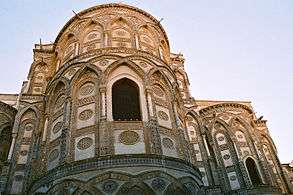
Oriental influence
The pointed arch, one of the defining attributes of Gothic, appears in Late Roman Byzantine architecture and the Sasanian architecture of Iran during late antiquity, although the form had been used earlier, as in the possibly 1st century AD Temple of Bel, Dura Europos in Roman Mesopotamia.[40] In the Roman context it occurred in church buildings in Syria and occasional secular structures, like the Karamagara Bridge in modern Turkey. In Sassanid architecture parabolic and pointed arches were employed in both palace and sacred construction.[41] A very slightly pointed arch built in 549 exists in the apse of the Basilica of Sant'Apollinare in Classe in Ravenna, and slightly more pointed example from a church, built 564 at Qasr Ibn Wardan in Roman Syria.[42] Pointed arches' development may have been influenced by the elliptical and parabolic arches frequently employed in Sasanian buildings using pitched brick vaulting, which obviated any need for wooden centring and which had for millennia been used in Mesopotamia and Syria.[43] The oldest pointed arches in Islamic architecture are in the Dome of the Rock, completed in 691/2, while some others appear in the Great Mosque of Damascus, begun in 705.[44] The Umayyads were responsible for the oldest significantly pointed arches in medieval western Europe, employing them alongside horseshoe arches in the Great Mosque of Cordoba, built from 785 and repeatedly extended.[45] The Abbasid palace at al-Ukhaidir employed pointed arches in 778 as a dominant theme both structural and decorative throughout the façades and vaults of the complex, while the tomb of al-Muntasir, built 862, employed a dome with a pointed arch profile. Abbasid Samarra had many pointed arches, notably its surviving Bab al-ʿAmma (monumental triple gateway). By the 9th century the pointed arch was used in Egypt and North Africa: in the Nilometer at Fustat in 861, the 876 Mosque of Ibn Tulun in Cairo, and the 870s Great Mosque of Kairouan. Through the 8th and 9th centuries, the pointed arch was employed as standard in secular buildings in architecture throughout the Islamic world.[46] The 10th century Aljafería at Zaragoza displays numerous forms of arch, including many pointed arches decorated and elaborated to a level of design sophistication not seen in Gothic architecture for a further two centuries.[45]
Increasing military and cultural contacts with the Muslim world, including the Norman conquest of Islamic Sicily between 1060 and 1090, the Crusades, beginning 1096, and the Islamic presence in Spain, may have influenced mediaeval Europe's adoption of the pointed arch, although this hypothesis remains controversial.[47][48] The structural advantages of pointed arches seems first to have been realised in a medieval Latin Christian context at the abbey church known as Cluny III at Cluny Abbey.[49] Begun by abbot Hugh of Cluny in 1089, the great Romanesque church of Cluny III was the largest church in the west when completed in 1130.[50] Kenneth John Conant, who excavated the site of the church's ruins, argued that the architectural innovations of Cluny III were inspired by the Islamic architecture of Sicily via Monte Cassino.[49] The Abbey of Monte Cassino was the foundational community of the Benedictine Order and lay within the Norman Kingdom of Sicily, which at that time was majority Muslim and predominantly Arabic-speaking. The rib vault with pointed arches was used at Lessay Abbey in Normandy in 1098,[51] and at Durham Cathedral in England at about the same time.[52] In those parts of the Western Mediterranean subject to Islamic control or influence, rich regional variants arose, fusing Romanesque, Byzantine and later Gothic traditions with Islamic decorative forms, as seen, for example, in Monreale and Cefalù Cathedrals, the Alcázar of Seville, and Teruel Cathedral.[53][54]
Structural elements
Pointed arches
One of the common characteristics the Gothic style is the pointed arch, which was widely used both in structure and decoration. The pointed arch did not originate in Gothic architecture; they had been employed for centuries in the Near East in pre-Islamic as well as Islamic architecture for arches, arcades, and ribbed vaults.[55] In Gothic architecture, particularly in the later Gothic styles, they became the most visible and characteristic element, giving a sensation of verticality and pointing upward, like the spires. Gothic rib vaults covered the nave, and pointed arches were commonly used for the arcades, windows, doorways, in the tracery, and especially in the later Gothic styles decorating the façades.[56] They were also sometimes used for more practical purposes, such as to bring transverse vaults to the same height as diagonal vaults, as in the nave and aisles of Durham Cathedral, built in 1093.[57]
The earliest Gothic pointed arches were lancet lights or lancet windows, narrow windows terminating in a lancet arch, an arch with a radius longer than their breadth and resembling the blade of a lancet.[58][59] In the 12th century First Pointed phase of Gothic architecture, also called the Lancet style and before the introduction of tracery in the windows in later styles, lancet windows predominated Gothic building.[60]
The Flamboyant Gothic style was particularly known for such lavish pointed details as the arc-en-accolade, where the pointed arch over a doorway was topped by a pointed sculptural ornament called a fleuron and by pointed pinnacles on either side. the arches of the doorway were further decorated with small cabbage-shaped sculptures called "chou-frisés".[61]
 Eastern end of Wells Cathedral (begun 1175)
Eastern end of Wells Cathedral (begun 1175).jpg) West front of Reims Cathedral, pointed arches within arches (1211-1275)
West front of Reims Cathedral, pointed arches within arches (1211-1275)- Lancet windows of transept Salisbury Cathedral (1220-1258)
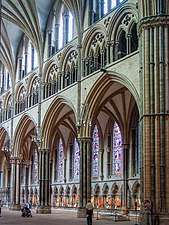 Pointed arches in the arcades, triforium and clerestory of Lincoln Cathedral (1185-1311)
Pointed arches in the arcades, triforium and clerestory of Lincoln Cathedral (1185-1311) A detail of the windows and galleries of the west front of Strasbourg Cathedral (1215-1439)
A detail of the windows and galleries of the west front of Strasbourg Cathedral (1215-1439)
Rib vault
The Gothic rib vault was one of the essential elements that made possible the great height and large windows of the Gothic style. Unlike the semi-circular barrel vault vault of Roman and Romanesque buildings, where the weight pressed directly downward, and required thick walls and small windows, the Gothic rib vault was made of diagonal crossing arched ribs. These ribs directed the thrust outwards to the corners of the vault, and downwards via slender colonettes and bundled columns, to the pillars and columns below. The space between the ribs was filled with thin panels of small pieces of stone, which were much lighter than earlier groin vaults. The outward thrust against the walls was countered by the weight of buttresses and later flying buttresses. As a result, the massive thick walls of Romanesque buildings were no longer needed; Since the vaults were supported by the columns and pillars, the walls between the columns could be thinner and higher, and filled with windows.[62][17][63]
The earlier Gothic rib vaults, used at Sens Cathedral (begun between 1135–40) and Notre-Dame de Paris (begun 1163), were divided by the ribs into six compartments. They were very difficult to build, and could only cross a limited space. Since each vault covered two bays, they needed support on the ground floor from alternating columns and pillars. In later construction, the design was simplified, and the rib vaults had only four compartments. The alternating rows of alternating columns and pillars receiving the weight of the vaults was replaced by simple pillars, each receiving the same weight. A single vault could cross the nave. This method was used at Chartres Cathedral (1194-1220), Amiens Cathedral (begun 1220), and Reims Cathedral.[64] The four-part vaults made it possible for the building to be yet higher. Notre-Dame de Paris, begun in 1163 with six-part vaults, reached a height of 35 meters, remarkable for the time. Amiens Cathedral, begun in 1220 with the newer four-part ribs, reached the height of 42.30 meters (138.8 feet) at the transept.[62][65]
 Early six-part rib vaults in Sens Cathedral (1135-1164)
Early six-part rib vaults in Sens Cathedral (1135-1164)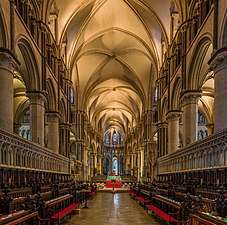 Rib vaults of choir of Canterbury Cathedral (1174-77)
Rib vaults of choir of Canterbury Cathedral (1174-77).jpg) Stronger four-part rib vaults in nave of Reims Cathedral (1211-1275)
Stronger four-part rib vaults in nave of Reims Cathedral (1211-1275) Structure of an early six-part Gothic rib vault. (Drawing by Eugene Viollet-le-Duc)
Structure of an early six-part Gothic rib vault. (Drawing by Eugene Viollet-le-Duc)
Flying buttresses
An important feature of Gothic architecture was the flying buttress, a half-arch outside the building which carried the thrust of weight of the roof or vaults inside over a roof or an aisle to a heavy stone column. The buttresses were placed in rows on either side of the building, and were often topped by heavy stone pinnacles, both to give extra weight and for additional decoration.[66]
Buttresses had existed since Roman times, usually set directly against the building, but the Gothic vaults were more sophisticated. In later structures, the buttresses often had several arches, each reaching in to a different level of the structure. The buttresses permitted the buildings to be both taller, and to have thinner walls, with greater space for windows.[66]
Over time, the buttresses and pinnacles became more elaborate supporting statues and other decoration, as at Beauvais Cathedral and Rheims Cathedral. The arches had an additional practical purpose; they contained lead channels which carried rainwater off the roof; it was expelled from the mouths of stone gargoyles placed in rows on the buttresses.[67]
Flying buttresses were used less frequently in England, where the emphasis was more on length than height. One notable example of English buttresses was Canterbury Cathedral, whose choir and buttresses were rebuilt in Gothic style by William of Sens and William the Englishman.[68] However, they were very popular in Germany: in Cologne Cathedral the buttresses were lavishly decorated with statuary and other ornament, and were a prominent feature of the exterior.
- Canterbury Cathedral with simple wall buttresses and flying buttresses (rebuilt into Gothic 1174-1177)
.jpg) East end of Lincoln Cathedral, with wall buttress, and chapter house with flying buttresses.(1185-1311)
East end of Lincoln Cathedral, with wall buttress, and chapter house with flying buttresses.(1185-1311)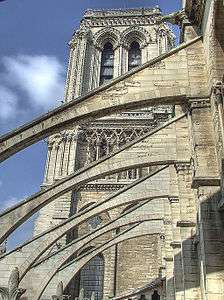 Flying buttresses of Notre Dame de Paris (c. 1230)
Flying buttresses of Notre Dame de Paris (c. 1230) Buttresses of Amiens Cathedral with pinnacles to give them added weight (1220-1266)
Buttresses of Amiens Cathedral with pinnacles to give them added weight (1220-1266)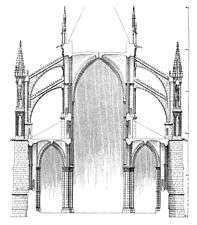 Section of Reims Cathedral showing the three levels of each buttress (1211-1275)
Section of Reims Cathedral showing the three levels of each buttress (1211-1275)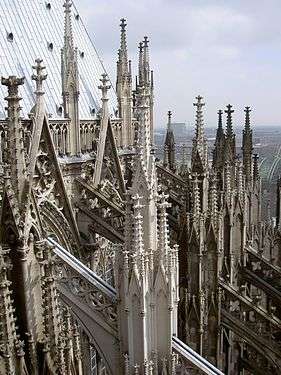 Decorated buttresses of Cologne Cathedral (1248-1573)
Decorated buttresses of Cologne Cathedral (1248-1573)
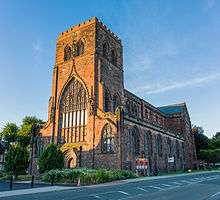
Towers and spires
Towers and spires were a common feature of Gothic buildings. They presented a dramatic spectacle of great height, could be tallest and most visible buildings in their city, and symbolised the aspirations of their builders toward heaven.[69] They also had a practical purpose; they often served as bell towers supporting belfries, whose bells told the time by announcing religious services, warned of fire or enemy attack, and celebrated special occasions like military victories and coronations. Sometimes the bell tower is built separate from a church; the best-known example of this is the Leaning Tower of Pisa.[69]
The towers, following the Romanesque tradition, were usually placed on the west front of the church. In Norman churches, towers were also sometimes placed over the nave, at the meeting point with the transept. Cathedrals and major churches in Normandy, often had multiple towers, built over the centuries; the Abbey of Saint-Étienne, Caen has nine towers and spires. Smaller churches, across Europe usually had a single tower on the west end.
The west front of Saint-Denis, with two towers of equal height on the west front, became the model for the early Gothic cathedrals in northern France, including Notre-Dame de Paris, and Laon Cathedral, Rheims Cathedral, and Amiens Cathedral.[70]
In addition to the main towers, some churches also had flèches, tall, needle-like towers, sometimes made of wood covered by lead and other metal, often with open frames. These were usually located where the transept crossed the nave. The most famous example was that of Notre-Dame de Paris. The original flèche of Notre-Dame was built on the crossing of the transept in the middle of the 13th century, and housed five bells. It was removed in 1786 during a program to modernise the cathedral, but was put back in an original form designed by Eugène Viollet-le-Duc. The new flèche, of wood covered with lead, was decorated with statues of the Apostles; the figure of St Thomas resembled Viollet-le-Duc.[71] The flèche was destroyed in the 2019 fire, but is being restored as of 2020.
Since large churches often were built over the course of several centuries, they illustrate the changing ideals of Gothic architecture. At Chartres Cathedral, the south tower was built in the 12th century, in the simpler Early Gothic, while the north tower is the more highly decorated flamboyant style. Chartres would have been even more exuberant if the second plan had been followed; it called for seven towers around the transept and sanctuary.[72] At Rouen Cathedral, two twelfth century towers flank a high tower in the Norman style tower capped by a very ornate flamboyant Gothic spire.[15]
Openwork spires of stone, sometimes of great height, were popular in the Flamboyant style, occurring singly at Strasbourg Cathedral, Burgos Cathedral, Freiburg Minster, Vienna Cathedral; and also at Cologne Cathedral and Ulm Minster, both designed in the mediaeval period but not realised until the late 19th century.
In England, during the Gothic era, there was a continuing fashion for three towers, with the largest being that over the crossing. This arrangement is seen at Canterbury, Wells, Lincoln, York, Lichfield, and Durham cathedrals. In England, wherever the ground was considered stable, the central tower was surmounted by a spire. Like the south spire of Chartres Cathedral, English spires are often constructed of masonry. The earliest is the comparatively small spire at Oxford Cathedral. The tallest mediaeval masonry spire is that built in the 13th century at Salisbury Cathedral (123 m [404 ft]). Others exist at Norwich and Chichester Cathedrals, while Lichfield Cathedral has three. Other cathedrals had tall spires of wooden construction sheathed with lead or copper. Two of these, on the central towers of Lincoln Cathedral and Old St Paul's Cathedral surpassed 550 feet in height and were the tallest structures prior to the 19th century.
England's Gothic parish churches and collegiate churches generally have a single western tower. A number of the finest churches have masonry spires, with those of St James Church, Louth; St Wulfram's Church, Grantham; St Mary Redcliffe in Bristol; and Coventry Cathedral. These spires all exceed 85 metres (280 feet) in height.[73]
In mainland Italy, the tower, if present, is sometimes detached from the building, as at Florence Cathedral, or projects from the side of the building as at the Basilica of Santa Croce. In Italy there is no defined stylistic break between Romanesque and Gothic, as the architects had a seemingly pragmatic approach to the use of round and pointed arches. Towers of apparently Romanesque form often appear in conjunction with otherwise Gothic structures. They tend to have graded series of openings in the Romanesque manner like the tower of the Badia Fiorentina. Some, like the tower at Santa Croce, have large openings of Gothic form and are surmounted by spires.
In addition to towers and spires, great mediaeval churches may have several other architectural forms rising above the roof-line, particularly over the crossing. These include the octagonal tower at Burgos Cathedral, the wooden octagonal tower at Ely Cathedral and the octagonal dome of Florence Cathedral, conceived in the late Gothic period and engineered by the Renaissance architect Filippo Brunelleschi.
Many churches never completed construction of all the planned towers. Initial plans for the rebuilding of the cathedral at Rheims called for seven spires, none of which were built, and while the two west towers were eventually finished, the two west front spires have never been built.[74] Similarly, Westminster Abbey's crossing tower has for centuries remained unbuilt, and numerous architects have proposed various ways of completing it since the 1250s, when work began on the tower under Henry III.[75] A century and half later, an octagonal roof lantern resembling that of Ely Cathedral was installed instead, which was then demolished in the 16th century.[75] Construction began again in 1724 to the design of Nicholas Hawksmoor, after first Christopher Wren had proposed a design in 1710, but stopped again in 1727. The crossing remains covered by the stub of the lantern and a 'temporary' roof.[75]
- Towers and Spires
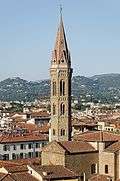 Badia Fiorentina – tall campanile with spire
Badia Fiorentina – tall campanile with spire St Stephan's Cathedral, Vienna – openwork stone spire
St Stephan's Cathedral, Vienna – openwork stone spire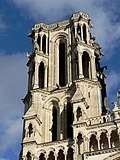 Laon Cathedral – strongly articulated paired towers of the west front. (North tower)
Laon Cathedral – strongly articulated paired towers of the west front. (North tower)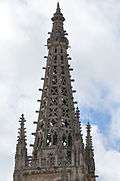 Openwork spire of Burgos Cathedral
Openwork spire of Burgos Cathedral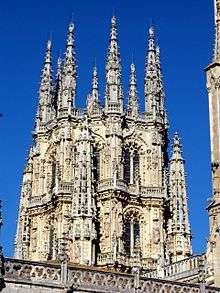 The octagonal tower of Burgos Cathedral (1221-1260), with an array of pinnacles.
The octagonal tower of Burgos Cathedral (1221-1260), with an array of pinnacles.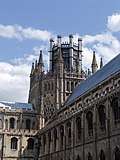 Ely Cathedral – wooden octagon on an octagonal stone crossing tower
Ely Cathedral – wooden octagon on an octagonal stone crossing tower Canterbury Cathedral – large central crossing tower
Canterbury Cathedral – large central crossing tower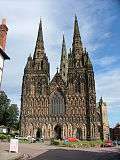 Lichfield Cathedral – three masonry spires, the crossing tower being taller.
Lichfield Cathedral – three masonry spires, the crossing tower being taller. Belfry of Bruges – stone octagonal belfry on a square tower (1280–), upper tower (1480s)
Belfry of Bruges – stone octagonal belfry on a square tower (1280–), upper tower (1480s)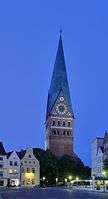 St John's Church, Lüneburg – very tall square brick steeple (1300–70)
St John's Church, Lüneburg – very tall square brick steeple (1300–70)
Tracery
%2C_cath%C3%A9drale_Saint-Pierre%2C_croisillon_sud%2C_parties_hautes_2.jpg)
Tracery is an architectural solution by which windows (or screens, panels, and vaults) are divided into sections of various proportions by stone bars or ribs of moulding.[76] Pointed arch windows of Gothic buildings were initially (late 12th–late 13th centuries) lancet windows, a solution typical of the Early Gothic or First Pointed style and of the Early English Gothic.[76][1] Plate tracery was the first type of tracery to be developed, emerging in the later phase of Early Gothic or First Pointed.[76] Second Pointed is distinguished from First by the appearance of bar-tracery, allowing the construction of much larger window openings, and the development of Curvilinear, Flowing, and Reticulated tracery, ultimately contributing to the Flamboyant style.[1] Late Gothic in most of Europe saw tracery patterns resembling lace develop, while in England Perpendicular Gothic or Third Pointed preferred plainer vertical mullions and transoms.[1] Tracery is practical as well as decorative, because the increasingly large windows of Gothic buildings needed maximum support against the wind.[77]
Plate tracery, in which lights were pierced in a thin wall of ashlar, allowed a window arch to have more than one light - typically two side-by-side and separated by flat stone spandrels.[76] The spandrels were then sculpted into figures like a roundel or a quatrefoil.[76] Plate tracery reached the height of its sophistication with the 12th century windows of Chartres Cathedral and in the "Dean's Eye" rose window at Lincoln Cathedral.[78]
At the beginning of the 13th century, plate tracery was superseded by bar-tracery.[76] Bar-tracery divides the large lights from one another with moulded mullions.[76] Bar-tracery, an important decorative element of Gothic styles, appeared first at Rheims and was employed in England around 1240.[76] After 1220, master builders in England had begun to treat the window openings as a series of openings divided by thin stone bars, while before 1230 the apse chapels of Rheims Cathedral were decorated with bar-tracery with cusped circles (with bars radiating from the centre).[78] Bar-tracery became common after c.1240, with increasing complexity and decreasing weight.[78] The lines of the mullions continued beyond the tops of the window lights and subdivided the open spandrels above the lights into a variety of decorative shapes.[76] Rayonnant style (c.1230–c.1350) was enabled by the development of bar-tracery in Continental Europe and is named for the radiation of lights around a central point in circular rose windows.[76] Rayonnant also deployed mouldings of two different types in tracery, where earlier styles had used moulding of a single size, with different sizes of mullions.[78] The rose windows of Notre-Dame de Paris (c.1270) are typical.[78]
The early phase of Middle Pointed style (late 13th century) is characterized by Geometrical tracery - simple bar-tracery forming patterns of foiled arches and circles interspersed with triangular lights.[76] The mullions of Geometrical style typically had capitals with curved bars emerging from them. Intersecting bar-tracery (c.1300) deployed mullions without capitals which branched off equidistant to the window-head.[76] The window-heads themselves were formed of equal curves forming a pointed arch and the tracery-bars were curved by drawing curves with differing radii from the same centres as the window-heads.[76] The mullions were in consequence branched into Y-shaped designs further ornamented with cusps. The intersecting branches produced an array of lozenge-shaped lights in between numerous lancet arched lights.Y-tracery was often employed in two-light windows c.1300.[76]
Second Pointed (14th century) saw Intersecting tracery elaborated with ogees, creating a complex reticular (net-like) design known as Reticulated tracery.[76] Second Pointed architecture deployed tracery in highly decorated fashion known as Curvilinear and Flowing (Undulating).[76] These types of bar-tracery were developed further throughout Europe in the 15th century into the Flamboyant style, named for the characteristic flame-shaped spaces between the tracery-bars.[76] These shapes are known as daggers, fish-bladders, or mouchettes.[76]
Third Pointed or Perpendicular Gothic developed in England from the later 14th century and is typified by Rectilinear tracery (panel-tracery).[76] The mullions are often joined together by transoms and continue up their straight vertical lines to the top of the window's main arch, some branching off into lesser arches, and creating a series of panel-like lights.[76] Perpendicular strove for verticality and dispensed with the Curvilinear style's sinuous lines in favour of unbroken straight mullions from top to bottom, transected by horizontal transoms and bars.[78] Four-centred arches were used in the 15th and 16th centuries to create windows of increasing size with flatter window-heads, often filling the entire wall of the bay between each buttress.[76] The windows were themselves divided into panels of lights topped by pointed arches struck from four centres.[76] The transoms were often topped by miniature crenallations.[76] The windows at Cambridge of King’s College Chapel (1446–1515) represent the heights of Perpendicular tracery.[78]
Tracery could also be found on the interior of buildings, covering the walls with overlaid tracery forming blind arcades. Tracery was also used for decorating the exterior: at Strasbourg Cathedral the west front is ornamented with elaborate bar tracery.[78]
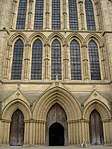 Lancet Gothic, Ripon Minster west front (begun 1160)
Lancet Gothic, Ripon Minster west front (begun 1160)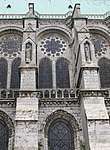 Plate tracery, Chartres Cathedral clerestory (1194-1220)
Plate tracery, Chartres Cathedral clerestory (1194-1220).jpg) Plate tracery, Lincoln Cathedral "Dean's Eye" rose window (c.1225)
Plate tracery, Lincoln Cathedral "Dean's Eye" rose window (c.1225)_crop.jpg) Geometrical Decorated Gothic, Ripon Minster east window
Geometrical Decorated Gothic, Ripon Minster east window Rayonnant rose window, Strasbourg Cathedral west front
Rayonnant rose window, Strasbourg Cathedral west front Flamboyant rose window, Amiens Cathedral west front
Flamboyant rose window, Amiens Cathedral west front- Curvilinear window, Limoges Cathedral nave
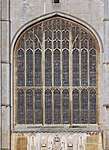 Perpendicular four-centred arch, King's College Chapel, Cambridge west front
Perpendicular four-centred arch, King's College Chapel, Cambridge west front- Early bar tracery in Soissons Cathedral (13th c.)
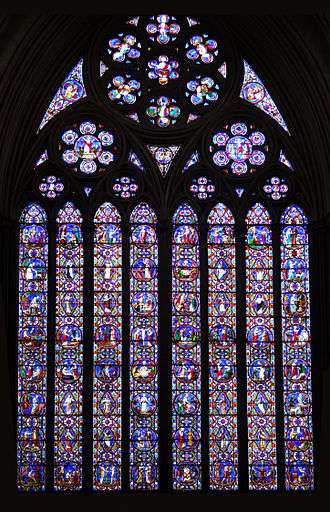 Bar-tracery, Lincoln Cathedral east window
Bar-tracery, Lincoln Cathedral east window- Flamboyant, Sainte-Chapelle de Vincennes, west front
 Blind tracery, Tours Cathedral (16th century)
Blind tracery, Tours Cathedral (16th century)
Transition from Romanesque to Gothic architecture
Elements of Romanesque and Gothic architecture compared
| # | Structural element | Romanesque | Gothic | Developments |
|---|---|---|---|---|
| 1 | Arches | Round | Pointed | The pointed Gothic arch varied from a very sharp form, to a wide, flattened form. |
| 2 | Vaults | Barrel or groin | Ribbed | Ribbed vaults appeared in the Romanesque era and were elaborated in the Gothic era. |
| 3 | Walls | Thick, with small openings | Thinner, with large openings | Wall structure diminshed during the Gothic era to a framework of mullions supporting windows. |
| 4 | Buttresses | Wall buttresses of low projection. | Wall buttresses of high projection, and flying buttresses | Complex Gothic buttresses supported the high vaults and the walls pierced with windows |
| 5 | Windows | Round arches, sometimes paired | Pointed arches, often with tracery | Gothic windows varied from simple lancet form to ornate flamboyant patterns |
| 6 | Piers and columns | Cylindrical columns, rectangular piers | Cylindrical and clustered columns, complex piers | Columns and piers developed increasing complexity during the Gothic era |
| 7 | Gallery arcades | Two openings under an arch, paired. | Two pointed openings under a pointed arch | The Gothic gallery became increasingly complex and unified with the clerestory |
Early development of Gothic architecture
One of the features that unifies the internal appearance of a major Gothic church is the emphasis on vertical elements, in particular attached shafts that pass from the floor to the vault. These first appeared in France in the early 11th century in churches that have broad ribs reinforcing a barrel vault. They are also seen at Lisbon and Speyer Cathedrals, Santiago de Compostela and la Madeleine Vezelay in conjunction with groin vaults, as well as at the three Norman cathedrals of East Anglia, of which Peterborough and Ely retain wooden ceilings, while Norwich was not vaulted until the 15th century.
The admission of light to the building through a multiplicity of windows was an important element in England. At Peterborough Cathedral, the polygonal Norman apse has remained, as has three tiers of large Norman windows, now filled with Gothic tracery and 19th century stained glass. The transept ends at Peterborough, Ely and Norwich each have three rows of large Norman windows. This grouping of windows prefigures the clusters of Gothic lancet windows that are found in many English churches such Salisbury Cathedral.
Rose windows, characteristic of the west fronts and transept ends of the churches of France, were common in architecture of Germany in the Romanesque period, where they appear in various forms at Worms Cathedral, and in Italy where they are either untraceried oculi or wheel windows such as that at the Basilica of San Zeno, Verona. The first rose window above the west portal in France is said to be that at the Abbaye Saint-Denis 1140.
Saint-Denis is generally cited as the first truly Gothic building, however the distinction is best reserved for the choir, of which the ambulatory remains intact. Noyon Cathedral saw the earliest completion of a rebuilding of an entire French cathedral in the new style from 1150 to 1231. While using all those features that came to be known as Gothic, including pointed arches, flying buttresses and ribbed vaulting, the builders continued to employ many of the features and much of the character of Romanesque architecture including round-headed arch throughout the building, varying the shape to pointed where it was functionally practical to do so.
At Saint-Denis, Sens Cathedral, Noyon Cathedral, Notre-Dame de Paris, and at the east end of Canterbury Cathedral, simple cylindrical columns predominate over the Gothic forms of clustered columns and shafted piers.
Wells Cathedral in England, where building commenced at the eastern end in 1175, was the first building in which the designer broke free from Romanesque forms. The architect entirely dispensed with the round arch in favour of the pointed arch and with cylindrical columns in favour of piers composed of clusters of shafts which lead into the mouldings of the arches. The transepts and nave were continued by Adam Locke in the same style and completed in about 1230. The character of the building is entirely Gothic. Wells Cathedral is thus considered the first truly Gothic cathedral.[79]
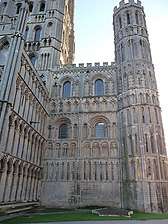
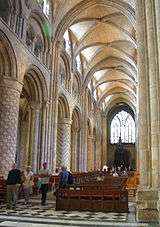
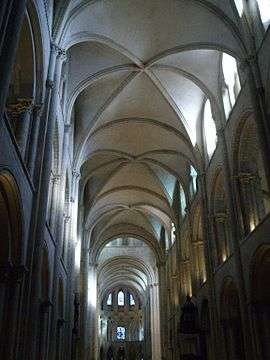
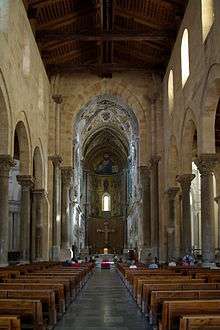
Plan, elevation and parts of a Gothic church
Plan
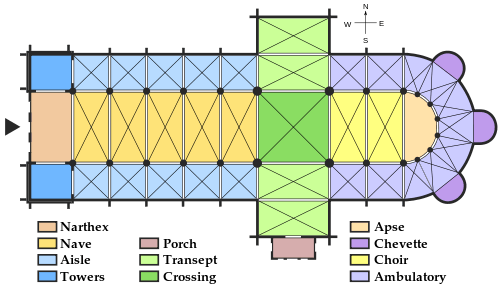
Most large Gothic churches and many smaller parish churches are of the Latin cross (or "cruciform") plan, with a long nave making the body of the church, a transverse arm called the transept and, beyond it, an extension which may be called the choir, chancel or presbytery. There are several regional variations on this plan. The area where the nave and transept meet is called the crossing, and in England is often surmounted by a stone tower, as at Salisbury Cathedral and York Minster, visible on a ground-plan by the sturdy piers that support the tower. (see below)
The nave is generally flanked on either side by aisles, usually single as at York Minster and Florence Cathedral but sometimes double as at Bourges and Cologne Cathedrals. (see plans below). Aisles may extend along the sides of the transepts as well, as at Cologne, Amiens Cathedral and York Minster.(see plans) In the South of France there is often a single wide nave and no aisles, as at Saint-Bertrand-de-Comminges and Albi Cathedrals.
In some churches with double aisles, or additional rows of chapels between the buttresses as at Notre-Dame de Paris, the transept does not project beyond the aisles (See plan). In English churches and cathedrals, transepts tend to project boldly and there may be two of them, as at Salisbury and Lincoln Cathedrals. The double transepts are to provide extra chapels, in lieu of the apsidal chapels found in major French churches (See Salisbury plan).
The eastern arm shows considerable diversity. In France and Germany, the eastern end is generally polygonal and surrounded by a continuation of the choir aisle called an ambulatory. Surrounding the ambulatory may be a ring of chapels called a "chevet".[80] In England the eastern arm is generally long and may have two distinct sections- choir and presbytery. It is almost always square ended with a cliff-like exterior face. Often there is a projecting Lady Chapel, dedicated to the Virgin Mary, as at Salisbury.[31][39][81] In Italy, the eastern projection beyond the transept is usually a shallow chapel or sometimes an apse.. See section below
The ground-plans of the churches show not only the larger parts of the building, developed for Catholic liturgy – the nave, aisles, transept, choir and chapels – but also reveal that each building contains a pattern of regular divisions called "bays". These bays or compartments are square, rectangular and sometimes trapezoidal, and are defined by the positions of the piers, columns and attached shafts that support the arcades and the overhead vaults. While internally the divisions are created by the locations of the vertical members, externally, the bays can be determined by the positions of the buttresses.[82]
Other elements that are visible on the plans are the locations of towers on the west fronts, porches such as those at Bourges and Salisbury, and the octagonal Chapter House at York Minster.
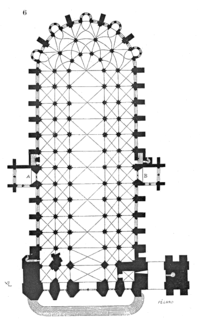


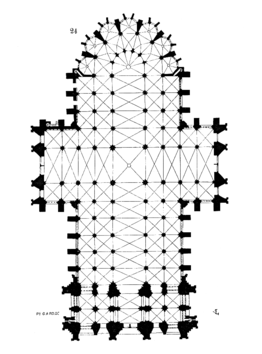
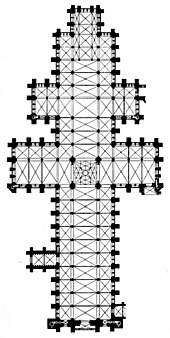
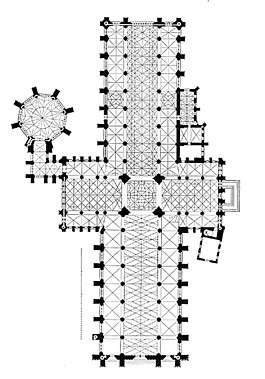
Elevation
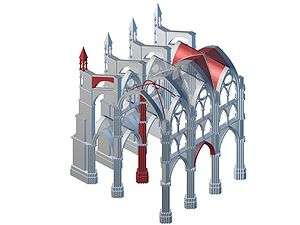
Gothic churches were typically built in basilica form. Architecturally, a basilica has a longitudinal nave, with a lower aisle on each side, separated by rows of columns or piers, and generally with windows let into that part of the nave that rises above the outer roof of the aisles. This upper section is called the clerestory. This architectural form is so named because it was commonly used by ancient Roman builders as the structure for secular basilicas used as halls for meetings, markets and as places of justice. Early Christian churches such as Santa Maria Maggiore, Rome, and San Apollinare in Classe have this form, which was adopted by Romanesque builders for their great abbeys and cathedrals, across Europe, such as Durham Cathedral, Abbey of Saint-Étienne, Caen, and Monreale Cathedral.
During the Gothic period, most churches were built with a single aisle on each side of the nave, such as Salisbury Cathedral, but some had double aisles with the outer lower than the inner, such as Bourges Cathedral. In the South of France Gothic churches are sometimes just a single high, wide hall, with tall windows but no aisles, and the lower stage giving a robust fortified appearance, such as Albi Cathedral. Gothic churches of the Germanic tradition, like St Stephen of Vienna, often have nave and aisles of similar height, without clerestory, and are called Hallenkirche.
Internally, the nave and choir are usually divided horizontally into three stages, the arcade, the triforium gallery and the clerestorey. This arrangement is usual in England where it can be seen at Salisbury, Lincoln, and Ely.
In some French Cathedrals, such as Laon and the nave of Rouen, there is a fourth stage, a shallow tribune gallery between the triforium and the clerestory. In the transepts of Notre-Dame, the wall above the triforium gallery is pierced with rose windows. In later Gothic churches, the vertical members in the tracery of galleries and clerestory may merge into a single decorative unit where the stages are present but not clearly defined, as at Saint-Ouen at Rouen and the choir of Gloucester Cathedral in England.
In the major Gothic churches of Italy, triforium galleries are most often found in churches influenced by the architecture of Normandy, and were used at abbeys of women, as a space for the nuns to attend services. Elsewhere, many churches such as Florence Cathedral and the Abbey Church of Santa Maria Novella, had an interior elevation of two stages, the arcade and clerestory.
- Elevations of Gothic churches in France, England, and Italy
 Notre Dame de Paris, showing the nave and double aisles; vault and flying buttresses.
Notre Dame de Paris, showing the nave and double aisles; vault and flying buttresses.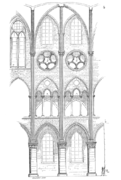 Notre Dame de Paris. Interior elevation of transept shows four stages- arcade, triforium gallery, tribune with rose windows and clerestory. Left- a later stage with larger windows.
Notre Dame de Paris. Interior elevation of transept shows four stages- arcade, triforium gallery, tribune with rose windows and clerestory. Left- a later stage with larger windows. Amiens Cathedral. Three stages- tall arcade, small gallery, and tall, traceried clerestory.
Amiens Cathedral. Three stages- tall arcade, small gallery, and tall, traceried clerestory. Saint Ouen, Rouen, left; Sees Cathedral, right. Saint Ouen shows a highly unified scheme where the triforium merges visually with the clerestory.
Saint Ouen, Rouen, left; Sees Cathedral, right. Saint Ouen shows a highly unified scheme where the triforium merges visually with the clerestory. Poitiers Cathedral, France. Hall church with high aisles and no clerestory. Large aisle windows between large square buttresses.
Poitiers Cathedral, France. Hall church with high aisles and no clerestory. Large aisle windows between large square buttresses.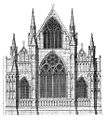 Lincoln Cathedral, elevation of the east end of typically English form with single aisles framing the central choir.
Lincoln Cathedral, elevation of the east end of typically English form with single aisles framing the central choir. Lincoln Cathedral. The proportions are low and wide compared to Notre Dame, the arcades are high and there are three stages.
Lincoln Cathedral. The proportions are low and wide compared to Notre Dame, the arcades are high and there are three stages.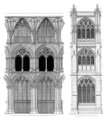 Ely Cathedral choir. Three stages, Decorated Gothic, but with proportions set by the earlier Norman nave. Exterior view shows windows into the high triforium arcade.
Ely Cathedral choir. Three stages, Decorated Gothic, but with proportions set by the earlier Norman nave. Exterior view shows windows into the high triforium arcade. Santa Maria Novella, Florence. Nave and aisle. Steep vaults and thick walls reduce the need for large external buttresses.
Santa Maria Novella, Florence. Nave and aisle. Steep vaults and thick walls reduce the need for large external buttresses. Santa Maria Novella, Two stage elevation with small round windows.
Santa Maria Novella, Two stage elevation with small round windows.
West front
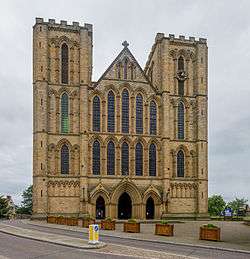
The façade of a large church, properly referred to as the West Front, is generally designed to create a powerful impression on the viewer, demonstrating both the might of God and the might of the institution that it represents. One of the best known and most typical of such west fronts is that of Notre-Dame de Paris. To emphasise its importance, the west front may be of a powerful design, with towers, imposing portals, jutting buttresses, gables, windows and an array of sculpture.
Central to the west front is the main portal, often flanked by additional doors, after the manner of Suger's west front at Saint-Denis. In England, the lateral doors may be present but relatively insignificant. In the arch of the central door, particularly in France, the tympanum, is often a significant piece of sculpture, most frequently Christ in Majesty or the Last Judgement. If there is a central doorjamb or a trumeau, then it frequently bears a statue of Jesus or the Madonna and Child if the dedication is to Mary. Figures in niches set into the mouldings around the portals.
Above the main portal there is a large window which lights the nave. In France and Spain this is generally a rose window as at Notre-Dame de Paris and Burgos Cathedral. In Italy there is generally an untraceried ocular window as at Santa Maria Novella. In England, rose windows are rare and the west end is generally dominated by a single very large traceried window as at York Minster and Canterbury, while some Early English fronts retain rows of lancet windows as at Salisbury and Ripon Cathedrals.
The west front of most major French churches and many English, Spanish and German ones have two towers, which can express an enormous diversity of form and decoration.[31][32] In Germany and Eastern Europe there may be a single tall tower at the western end as at Freiburg Minster. In England, where the principle tower is usually over the crossing, the west front may be framed by large turrets.
In Italy, with the exception of Milan Cathedral, the form of a Gothic west front is less strongly architectonic and sculptural than in other parts of Europe. The underlying structure may be brick, rather than stone, overlaid with a veneer of polychrome marble, and ornamented with marble sculpture and coloured mosaics as at Siena and Orvieto Cathedrals.
- West fronts
 Laon Cathedral – early Gothic towers modelled after the former towers of Saint-Denis
Laon Cathedral – early Gothic towers modelled after the former towers of Saint-Denis Notre-Dame de Paris – deep portals, a rose window, balance of horizontal and vertical elements
Notre-Dame de Paris – deep portals, a rose window, balance of horizontal and vertical elements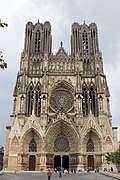 Rheims Cathedral – High Gothic and rayonnant Gothic (built c.1245–1400s). Spires were abandoned c. 1230s
Rheims Cathedral – High Gothic and rayonnant Gothic (built c.1245–1400s). Spires were abandoned c. 1230s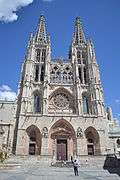 Burgos Cathedral – deep portals, rose window, elaborate openwork screen and spire
Burgos Cathedral – deep portals, rose window, elaborate openwork screen and spire Cologne Cathedral – massive towers with very tall spires, completed C19th.
Cologne Cathedral – massive towers with very tall spires, completed C19th. Orvieto Cathedral – balance of vertical, horizontal and diagonal, large portals, polychrome
Orvieto Cathedral – balance of vertical, horizontal and diagonal, large portals, polychrome.jpg) Salisbury Cathedral – wide sculptured screen, lancet windows, turrets with pinnacles
Salisbury Cathedral – wide sculptured screen, lancet windows, turrets with pinnacles Brussels Cathedral – gabled portal, large window, emphasis on vertical elements.
Brussels Cathedral – gabled portal, large window, emphasis on vertical elements.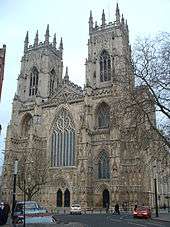 York Minster – shallow portal, very large traceried window, towers with pinnacles, vertical emphasis
York Minster – shallow portal, very large traceried window, towers with pinnacles, vertical emphasis
East end
The eastern end of Gothic churches shows significant regional variation in their ground plans and architecture.
In France the eastern end is generally polygonal and surrounded by a continuation of the choir aisle called an ambulatory. Surrounding the ambulatory may be a ring of chapels called a "chevet". In many cases the chevet comprises projecting apses, as at Saint-Denis and Amiens Cathedral where there are seven. This is also the case at Cologne Cathedral in Germany and Prague Cathedral in the Czech Republic, while Chartres Cathedral has three and the Basilica of Saint Anthony of Padua, had nine radiating square chapels.
In England the eastern arm is generally long and may have two distinct sections – choir and presbytery. The building usually terminates in a square and a cliff-like exterior face as at York Minster and Lincoln Cathedral. Often there is a projecting Lady Chapel, dedicated to the Virgin Mary, as at Salisbury, Wells, and Ripon Cathedrals.[31][39][81]
In Italy, the eastern projection beyond the transept is usually a shallow chapel, as at Santa Maria Novella. At Florence Cathedral there is a polygonal apse, identical in size and shape to the transepts, radiating from the dome. Milan Cathedral has a polygonal east end. The Gothic cathedrals at Siena and Orvieto are both constrained by their mountainous sites to have square ends.
- East ends
 Bourges Cathedral – double ambulatory and small apses
Bourges Cathedral – double ambulatory and small apses Notre-Dame de Paris – chevet
Notre-Dame de Paris – chevet Cologne Cathedral – chevet
Cologne Cathedral – chevet Milan Cathedral – projecting pentagonal range of chapels at the east end.
Milan Cathedral – projecting pentagonal range of chapels at the east end..jpg) Palma Cathedral – projecting apse
Palma Cathedral – projecting apse Ely Cathedral – square east end: Early English chancel (left) and Decorated Lady Chapel (right)
Ely Cathedral – square east end: Early English chancel (left) and Decorated Lady Chapel (right) St Albans Abbey – Lady Chapel projects from the east end as is often found in England.
St Albans Abbey – Lady Chapel projects from the east end as is often found in England. Albi Cathedral – apse
Albi Cathedral – apse Church of St Nicholas, Wismar – chevet
Church of St Nicholas, Wismar – chevet
Portals and the tympanum
Early Gothic churches traditionally have their main entrance at the western end of the church, opposite the choir. Based on the model of the Saint-Denis and Notre-Dame de Paris, there are usually three doorways with pointed arches. In the Romanesque style church portals were enriched by sculpture, and a carved figure often occupied the central jamb of the door. The main pictorial representation occupied the tympanum, the panel between the arch and the lintel of the door. The subject was usually the Last Judgement. This arrangement continued into the Gothic era.
One of the earliest portals of the Gothic period was that at Chartres Cathedral, where the three portals of the west front show the three epiphanies in the Life of Christ.[83] At Amiens, the tympanum over the central portal depicted the Last Judgement, the right portal showed the Coronation of the Virgin, and the left portal showed the lives of saints who were important in the diocese. This set a pattern of complex iconography which was followed at other churches.[64]
The iconography of the sculptural decoration on the façade was not left to the artists. An edict of the Second Council of Nicaea in 787 had set the rules: "The composition of religious images is not to be left to the inspiration of artists; it is derived from the principles put in place by the Catholic Church and religious tradition. Only the art belongs to the artist; the composition belongs to the Fathers."[84]
In France, the transept fronts were often elaborately treated like the west fronts, having rose windows and significant portals, sometimes, as at Chartres Cathedral, with large porches.
The portals and interiors were much more colourful than they are today. Each sculpture on the tympanum and in the interior was painted by the peintre imagier, or image painter, following a system of colours codified in the 12th century; yellow, called gold, symbolised intelligence, grandeur and virtue; white, called argent, symbolised purity, wisdom, and correctness; black, or sable, meant sadness, but also will; green, or sinople, represented hope, liberty and joy; red or gueules (see gules) meant charity or victory; blue or azure symbolised the sky, faithfulness and perseverance; and violet, or pourpre, was the colour of royalty and sovereignty.[85]
- Sculpted portals
 Chartres Cathedral, west front, triple portal
Chartres Cathedral, west front, triple portal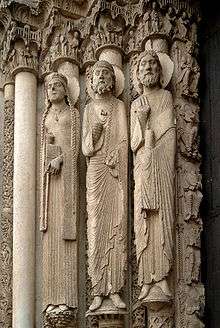 Chartres Cathedral, central portal
Chartres Cathedral, central portal Amiens Cathedral, central portal
Amiens Cathedral, central portal Amiens Cathedral, west front, "Christ in majesty"
Amiens Cathedral, west front, "Christ in majesty"- Strasbourg Cathedral, the "Wise and Foolish Virgins"
Architectural character
Height
A characteristic of Gothic church architecture is its height, both absolute and in proportion to its width, the verticality suggesting an aspiration to Heaven. A section of the main body of a Gothic church usually shows the nave as considerably taller than it is wide. In England the proportion is sometimes greater than 2:1, while the greatest proportional difference achieved is at Cologne Cathedral with a ratio of 3.6:1. The highest internal vault is at Beauvais Cathedral at 48 metres (157 ft).[31]
Externally, towers and spires are characteristic of Gothic churches both great and small, the number and positioning being one of the greatest variables in Gothic architecture. In Italy, the tower, if present, is almost always detached from the building, as at Florence Cathedral, and is often from an earlier structure. In France and Spain, two towers on the front is the norm. In England, Germany and Scandinavia this is often the arrangement, but an English cathedral or abbey church may also be surmounted by an enormous tower at the crossing. Smaller churches usually have just one tower, but this may also be the case at larger buildings, such as Salisbury Cathedral or Ulm Minster, which has the tallest spire in the world,[86] slightly exceeding that of Lincoln Cathedral, the tallest which was actually completed during the mediaeval period, at 160 metres (520 ft).
- External Height
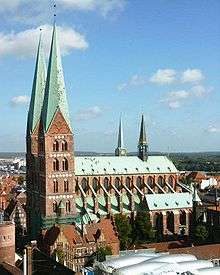 St Mary's Church, Lübeck – tallest wood and copper spires in the world. (Rebuilt after WWII.)
St Mary's Church, Lübeck – tallest wood and copper spires in the world. (Rebuilt after WWII.) Lincoln Cathedral – large central tower once carried the tallest spire in the world.
Lincoln Cathedral – large central tower once carried the tallest spire in the world.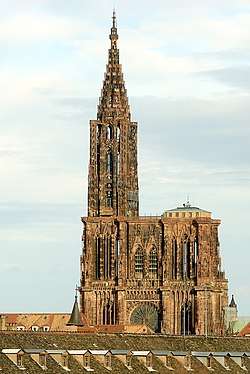 Strasbourg Cathedral – openwork spire, tallest stone spire of the Gothic era.
Strasbourg Cathedral – openwork spire, tallest stone spire of the Gothic era.- Salisbury Cathedral – tallest spire of the 13th century and tallest masonry spire ever built.
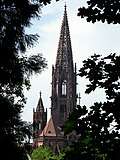 Freiburg Minster – tallest remaining medieval spire in Germany.
Freiburg Minster – tallest remaining medieval spire in Germany.- Florence Cathedral – dome designed c.1370, engineered by Brunelleschi 15th century.
- Internal Height
 Westminster Abbey nave, 31 m (102 ft)
Westminster Abbey nave, 31 m (102 ft)- Amiens Cathedral choir, 42.3 m (139 ft)
 Cologne Cathedral choir, 43.35 m (142.2 ft)
Cologne Cathedral choir, 43.35 m (142.2 ft)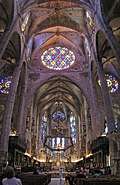 Palma Cathedral, Mallorca, nave, 44 m (144 ft)
Palma Cathedral, Mallorca, nave, 44 m (144 ft) Florence Cathedral nave, 45 m (148 ft)
Florence Cathedral nave, 45 m (148 ft) Beauvais Cathedral choir, 47.5 m (156 ft)
Beauvais Cathedral choir, 47.5 m (156 ft)
Vertical emphasis
The pointed arch lends itself to a suggestion of height. This appearance is characteristically further enhanced by both the architectural features and the decoration of the building.[81]
On the exterior, the verticality is emphasised in a major way by the towers and spires and in a lesser way by strongly projecting vertical buttresses, by narrow half-columns called attached shafts which often pass through several storeys of the building, by long narrow windows, vertical mouldings around doors and figurative sculpture which emphasises the vertical and is often attenuated. The roof-line, gable ends, buttresses and other parts of the building are often terminated by small pinnacles, Milan Cathedral being an extreme example in the use of this form of decoration.
On the interior of the building attached shafts often sweep unbroken from floor to ceiling and meet the ribs of the vault, like a tall tree spreading into branches. The verticals are generally repeated in the treatment of the windows and wall surfaces. In many Gothic churches, particularly in France, and in the Perpendicular style of English Gothic architecture, the treatment of vertical elements in gallery and window tracery creates a strongly unifying feature that counteracts the horizontal divisions of the interior structure.[81]
 Rhiems Cathedral, west front
Rhiems Cathedral, west front- Beauvais Cathedral, east end
 York Minster, north transept, the Five Sisters window
York Minster, north transept, the Five Sisters window Bourges Cathedral, nave, clustered column
Bourges Cathedral, nave, clustered column Cologne Cathedral, galleries
Cologne Cathedral, galleries Cologne Cathedral, choir, flying buttresses and pinnacles
Cologne Cathedral, choir, flying buttresses and pinnacles
Light
Increasing the amount of light in the interior was a primary objective of the founders of the Gothic movement, especially Abbot Suger, who was an advisor and minister of King Louis VI and Louis VII, and the creator of the first Gothic structure in France, the rebuilt Basilica of Saint Denis. He described the new kind of architecture he created at Saint Denis: "a circular ring of chapels, by virtue of which the whole church would shine with the wonderful and uninterrupted light of most luminous windows, pervading the interior beauty.".[87]
Suger was a follower the philosopher John Scotus Eriugena (810-877), who wrote that God was "the supra-essential light", and of a Sixth Century mystic and philosopher called the Pseudo-Dionysius, who wrote that all visible things are "material lights" which reflected the infinite light of God himself. Therefore Suger ordered his architects to remodel the Basilica to bring in the maximum amount of light.[87]


.jpg)
.jpg)
.jpg)
.jpg)
Evolving styles
Between the dedication of the choir at Saint-Denis, Paris, in 1144 and the completion of Henry VII's Chapel at Westminster Abbey in 1519, there were nearly 400 years of stylistic development in Gothic architecture. Nowhere was this more manifest that in the building of cathedrals and the great churches of abbeys, colleges and prosperous towns.
While the plan and elevation of the various types of Gothic ecclesiastical architecture remained consistently linked to purpose and to regional preferences, all the other elements developed, generally towards greater complexity, over the decades. The piers, the arcades, the galleries, the vaults and the portals, all evolved. The evolution was largely linked to and dependent upon the structural and ornamental flexibility of the pointed arch.
This development is traditionally divided into periods or styles according to the system of the 19th century French archaeologist Arcisse de Caumont.[88] The periods are generally called Early Gothic (1137–1180), High Gothic (1180–1230), Rayonnant Gothic (1230–1350 and Flamboyant Gothic (1350–1530). These terms apply to the Gothic architecture of France and to those countries where the influence of French Gothic spread. These styles did not, however, progress at the same rate, or in the same way in every country.
In England, the reconstruction of Westminster Abbey and the east end of Canterbury Cathedral were both influenced by French Gothic, with the architect at Canterbury being William of Sens.[89] Wells Cathedral, however, takes a completely different direction to French Gothic, introducing an unprecedented use of fluted mouldings, and other decorative innovations. Salisbury Cathedral and the nave of Lincoln are also very different to the French prototypes. Hence, the styles of English Gothic are referred to as Early English (or Lancet) Gothic (c. 1180–1275), Geometric Decorated and Flamboyant Decorated Gothic, (c. 1275–1380); and Perpendicular Gothic, (c. 1380–1520), after the system proposed by Thomas Rickman.[90]
One of the indicators of style is the nature of the windows and doors, and their decorative treatment. This is strongly associated with and affected by the type of arches used within the particular building. The Gothic styles, Lancet, Geometric, Rayonnant, Flamboyant and Perpendicular, affected all the various forms of architectonic decoration within the church – arcading, niches, shrines, wooden panelling, furniture of all sorts, reliquaries, vessels, and vestments.
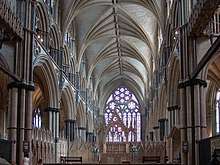
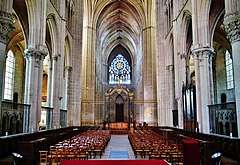
.jpg)
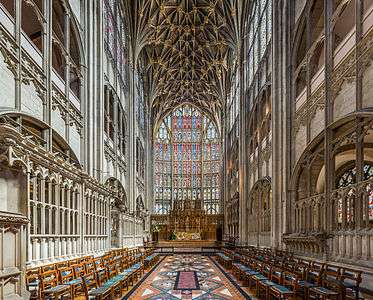
Arches, windows and tracery
Early or Lancet Gothic
The simplest shape of a Gothic window is a long opening with a pointed arch known in England as the lancet. Lancet windows may be used singly, as in the nave of Lincoln Cathedral, or grouped, as in the nave of Salisbury Cathedral where they are in two in the aisles and threes in the clerestory. Because large lancet windows, such as those lighting the aisles of a church may be wide in comparison to a single light in a traceried window, they often have armatures of wood or iron to support the glass. The arch of a lancet opening is often equilateral, but sometimes is much more acute, and when employed in the arcade of a choir apse, such as at Westminster Abbey, adds to the emphasis of height.
The simple shape of the lancet arch may appear in Early Gothic buildings on openings of all types, doorways, niches, arcades, including galleries; and belfry openings.
The use of lancet windows is found in the Early Gothic architecture of France, at Saint-Denis, and Sens and Senlis cathedrals. At Chartres and Laon cathedrals lancet windows are grouped beneath the rose windows. Tall narrow lancets are also found in radiating groups in the chancel apses of some churches, such as Chartres Cathedral. It is common in France for lancet windows to be used in smaller, narrower spaces, such as the chapels of a chevet, while traceries windows are used in the clerestory.
The style Lancet Gothic is known in England as Early English Gothic, with Salisbury Cathedral being the prime example. York Minster has a group of lancet windows each fifty feet high and still containing ancient glass. They are known as the Five Sisters.[31][36] Wells Cathedral is notable for the continuous rows of lancet openings that make up the triforiun galleries. Lancet windows are used extensively in the Gothic churches of Italy, including Florence Cathedral and in the Brick Gothic churches of Germany and Poland.
Geometric Gothic (England)
The Equilateral Arch lends itself to filling with tracery of simple equilateral, circular and semi-circular forms. In France, windows of clerestorys, and other larger windows were commonly divided into two lights, with some simple Geometric tracery above, a circle or a cinquefoil or sexfoil. This style of window remained popular without great change until after 1300.
In England there was a much greater variation in the design of tracery that evolved to fill these spaces. The style is known as Geometric Decorated Gothic and can be seen to splendid effect at many English cathedrals and major churches, where both the eastern and the western terminations of the building may be occupied by a single large window such as the east window at Lincoln and the west window at Worcester Cathedral. Windows of complex design and of three or more lights or vertical sections, are often designed by overlapping two or more equilateral arches springing from the vertical mullions.[36]
Rayonnant Gothic
Rayonnant is the term used particularly to described the style that produced the great rose windows of France. These windows deck not only the west fronts of churches, but often, as at Notre-Dame de Paris, the transept gables as well. It is common that although the transepts of French churches do not project strongly, they are given visual importance almost equal to the west front, including large decorated portals and a rose window. Particularly fine examples are at Notre-Dame and Chartres Cathedral.[91]
Flamboyant Gothic
The Flamboyant Arch is one that is drafted from four points, the upper part of each main arc turning upwards into a smaller arc and meeting at a sharp, flame-like point. These arches create a rich and lively effect when used for window tracery and surface decoration. The form is structurally weak and has very rarely been used for large openings except when contained within a larger and more stable arch. It is not employed at all for vaulting.[31]
Some of the most beautiful and famous traceried windows of Europe employ this type of tracery. It can be seen at St Stephen's Vienna, Sainte-Chapelle in Paris, at the Cathedrals of Limoges and Rouen in France. In England the most famous examples are the West Window of York Minster with its design based on the Sacred Heart, the extraordinarily rich nine-light East Window at Carlisle Cathedral and the exquisite East window of Selby Abbey.[36][39]
Doorways surmounted by Flamboyant mouldings are very common in both ecclesiastical and domestic architecture in France. They are much rarer in England. A notable example is the doorway to the Chapter Room at Rochester Cathedral.[31][36]
The style was much used in England for wall arcading and niches. Prime examples in are in the Lady Chapel at Ely, the Screen at Lincoln and externally on the façade of Exeter Cathedral. In German and Spanish Gothic architecture it often appears as openwork screens on the exterior of buildings. The style was used to rich and sometimes extraordinary effect in both these countries, notably on the famous pulpit in Vienna Cathedral.[32]
Perpendicular Gothic (England)
The depressed or four-centred arch is much wider than its height and gives the visual effect of having been flattened under pressure. Its structure is achieved by drafting two arcs which rise steeply from each springing point on a small radius and then turn into two arches with a wide radius and much lower springing point.[31]
This type of arch, when employed as a window opening, lends itself to very wide spaces, provided it is adequately supported by many narrow vertical shafts. These are often further braced by horizontal transoms. The overall effect produces a grid-like appearance of regular, delicate, rectangular forms with an emphasis on the perpendicular. It is also employed as a wall decoration in which arcade and window openings form part of the whole decorative surface.
The style, known as Perpendicular, that evolved from this treatment is specific to England, although very similar to contemporary Spanish style in particular, and was employed to great effect through the 15th century and first half of the 16th as Renaissance styles were much slower to arrive in England than in Italy and France.[31]
It can be seen notably at the East End of Gloucester Cathedral where the East Window is said to be as large as a tennis court. There are three very famous royal chapels and one chapel-like Abbey which show the style at its most elaborate: King's College Chapel, Cambridge; St George's Chapel, Windsor; Henry VII's Chapel at Westminster Abbey and Bath Abbey.[36] However very many simpler buildings, especially churches built during the wool boom in East Anglia, are fine examples of the style.
Columns and piers
In France, tall untapered columns were common in the Romanesque style. The use of columns of this type was rare in Norman England, where at Durham, Gloucester and Hereford there were massive circular piers built of masonry, and at Durham, alternating with rectangular piers.
In Early French Gothic architecture, the columns became much more Classical in shape, proportion and the nature of the capital, which was often a modification of the Corinthian capital. Columns of this type were used at the abbey at Saint-Denis, at Sens, at Notre-Dame and at Canterbury in England. In buildings with sexpartite vaults, they sometimes alternated with piers.
In the Brabantine Gothic architecture of the Holland and Belgium, columns remained part of the style into the 15th century, and have capitals of cabbage leaf foliage.
In France, the column developed in complexity by having a cluster of circular shafts grouped around the central circular core. This is seen a Rheims, Amiens and Bourges Cathedrals, and also at Westminster Abbey and Salisbury Cathedral and in Spain at Burgos Cathedral.
The rectangular piers also developed, with attached shafts and mouldings which continue up the wall to support the vault, or into the decorative mouldings of the chancel arch, in a manner that had previously been utilised to decorate the arches of Romanesque portals. The eastern end of the Abbey of Saint-Étienne, Caen, was rebuilt from 1166, with clustered piers. From 1176, Wells Cathedral was constructed with clustered piers throughout. Between the two buildings there is a great difference in the handling of the two. At Caen, the pier remains a decorated rectangular pier, set parallel to the wall surface. The shafts themselves maintain a circular, and classicising form. At Well, the core of the pier appears to have been rotated, and become a lozenge, angle-on to the lie of the arcade. The clusters of shafts are fluting. The capitals are of what is known as "stiff-leaf" foliage, and has a vitality of form different to any other foliage carving of that date.
Complex clustered columns and fluted and shafted piers were subsequently widely adopted, and became part of the vertical visual character of Gothic churches.
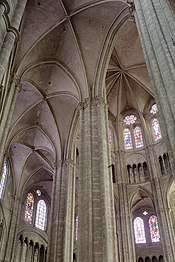

_(16466400434).jpg)
.jpg)
Developments in ribbed vaulting
_Basilique_Sainte-Marie-Madeleine_-_Int%C3%A9rieur_-_10.jpg)
In France the vaults over the high spaces of nave and clerestory, in the Early Gothic period, was sexpartite, spanning two bays of the nave. This resulted in the vaulted space being almost square, and to diagonal ribs being semi-circular. Only the arches of the transverse ribs were pointed. This is the case at Sens, at Notre-Dame de Paris and the Nave of Laon Cathedral.
At Chartres Cathedral, and the choir of Laon Cathedral, however, the vault is in four parts, spans a single bay, is rectangular, and all the ribs are pointed. The quadripartite proved much easier to build because it required less centring. It is also stronger as the compartments are smaller. The quadripartite vault is used in the Early English cathedrals of Salisbury and Wells. It became the standard form of vault which lent itself to further development and elaboration.
In the nave of Lincoln Cathedral the vault acquired extra ribs known as tiercerons which meet at a central ridge rib running the length of the nave. An additional elaboration, to span the wide nave, was the introduction of intermediate ribs which do not reach the centre of the vault, but join two small lierne ribs projecting from the ridge. Other cathedrals with tierceron vaulting are Norwich, and Exeter.
Lierne ribs became a feature of later Gothic design, as at Bristol Cathedral and led the way to elaborate patterns within the vault, including reticular vaulting and stellar vaulting. Stellar vaulting was particularly fashionable in Germany, Eastern Europe and Spain. The use of short ribs lent itself to the introduction of curved and ogee shaped ribs, in the Flamboyant style. Flamboyant vaulting is particularly prevalent in Spain.
In England there are a number of chapter house, notably at Wells, Lincoln and Westminster Abbey, where the vault is supported by a single central column from which many ribs radiate in every direction like a palm tree. This also occurs at the high vault behind the altar at Jacobins Church (1275–1292), Toulouse, in France.
A further development was many shallow ribs radiating in a fan shape, so that visually, the appearance of the structural ribs is minimised, and the emphasis is upon the curving surfaces. These fan vaults were used successfully for narrower and lower structures such as the cloister at Gloucester Cathedral and the retrochoir at Peterborough, before being employed on the high vaults at the Chapel of Kings College Cambridge, and even even more elaborate form with pendant lanterns attached, at Henry VII's Chapel at Westminster Abbey.
 Notre-Dame de Paris – square, sexpartite vaults spanning two nave bays
Notre-Dame de Paris – square, sexpartite vaults spanning two nave bays Salisbury Cathedral – rectangular quadripartite vault over single bay
Salisbury Cathedral – rectangular quadripartite vault over single bay Lincoln Cathedral – quadripartite form, with tierceron ribs and ridge rib with carved bosses.
Lincoln Cathedral – quadripartite form, with tierceron ribs and ridge rib with carved bosses.- Bremen Cathedral – north aisle, a reticular (net) vault with intersecting ribs.
 Church of the Assumption, St Marein, Austria – stellar vault with intersecting lierne ribs.
Church of the Assumption, St Marein, Austria – stellar vault with intersecting lierne ribs. Salamanca Cathedral, Spain – vault has Flamboyant S-shaped and circular lierne ribs.
Salamanca Cathedral, Spain – vault has Flamboyant S-shaped and circular lierne ribs..jpg) Church of the Jacobins, Toulouse – palm tree vault
Church of the Jacobins, Toulouse – palm tree vault- Peterborough Cathedral, retrochoir – fan vaulting
Stained glass windows
One of the most prominent features of Gothic architecture was the use of stained glass window, which steadily grew in height and size and filled Gothic churches with light and colour. Nineteenth century art historians including Viollet-le-Duc, Focillon, Aubert, and Max Dvořák contended that this is one of the most universal features of the Gothic style.[92]
Religious teachings in the Middle Ages, particularly the writings of Pseudo-Dionysius, a 6th-century mystic whose book, De Coelesti Hierarchia, was popular among monks in France, taught that all light was divine.[93] When the Abbot Suger ordered the reconstruction of choir of the his abbey church at Saint-Denis, he had the builders create seventy windows, admitting as much light as possible, as the means by which the faithful could be elevated from the material world to the immaterial world.[93]
Many earlier Romanesque churches had stained glass windows, and many had round windows, called oculi, but these windows were necessarily small, due to the thickness of the walls. The primary interior decorations of Romanesque and Gothic churches were painted murals. In the Gothic style, the improvements in rib vaults and flying buttresses allowed cathedral walls to be higher, thinner and stronger, and windows were consequently considerably larger. The windows of churches in the late Gothic period, such as Sainte-Chapelle in Paris, filled the entire wall between the ribs of stone. Enormous windows were also an important element of York Minster and Gloucester Cathedral.[81]
The main threat to large windows was the wind; frames had to be extremely strong to sustain wind load. The early windows were fit into openings cut into the stone. The small pieces of glass were coloured, and then had the color fixed by baking in an oven. Details such as faces were painted when the glass was cold. The pieces were joined together within lead frames into panels, which were then combined in larger and stronger lead frames. Then the finished window was set into the stone opening. Thin vertical and horizontal bars of iron, called vergettes or barlotierres, were placed inside the window to reinforce the glass against the wind.[94]
The stories told in the glass were usually episodes from the Bible, but they also sometimes illustrated the professions of the guilds which had funded the windows, such as the drapers, stonemasons or the barrel-makers.[95]
Much of the stained glass in Gothic churches today dates from later restorations, but a few, notably Chartres Cathedral and Bourges Cathedral, still have many of their original windows.[95]
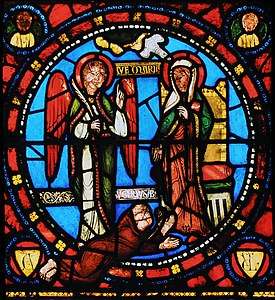 Abbey of Saint-Denis, Abbot Suger represented at feet of Virgin Mary (12th century)
Abbey of Saint-Denis, Abbot Suger represented at feet of Virgin Mary (12th century) South transept rose window of Chartres Cathedral (1221–1230)
South transept rose window of Chartres Cathedral (1221–1230)- Detail of the Apocalypse window, Bourges Cathedral, early 13th century
.jpg) South Oculus of Canterbury Cathedral. It contains fourteen of the original glass sections from the 12th century
South Oculus of Canterbury Cathedral. It contains fourteen of the original glass sections from the 12th century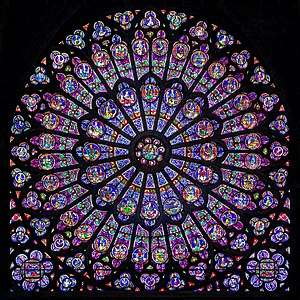
Sculpture and decoration
The exteriors and interiors of Gothic churches, were lavishly ornamented with sculpture and decoration on religious themes, designed for the great majority of parishioners who could not read. They were described as "Books for the poor." To add to the effect, all of the sculpture on the façades was originally painted and gilded.[96]
Each feature of the church had a symbolic meaning. The main portals at Notre-Dame de Paris, for instance, represented the entrance to paradise, with the Last Judgement depicted on the tympanum over the doors, showing Christ surrounded by the apostles, and by the signs of the zodiac, representing the movements of the heavens. The columns below the tympanum are in the form of statues of saints, literally reprinting them as "the pillars of the church."[97] Each saint had his own symbol: a winged lion stood for Saint Mark, an eagle with four wings meant Saint John the Apostle, and a winged bull symbolized Saint Luke. Sculpted angels had specific functions, sometimes as heralds, blowing trumpets, or holding up columns, as guardian angels; or holding crowns of thorns or crosses, as symbols of the crucifixion of Christ, or waving a container with incense, to illustrate their function at the throne of God. Floral and vegetal decoration was also very common, representing the Garden of Eden; grapes represented the wines of Eucharist.[97]
The tympanum over the central portal on the west façade of Notre-Dame de Paris vividly illustrates the Last Judgement, with figures of sinners being led off to hell, and good Christians taken to heaven. The sculpture of the right portal shows the coronation of the Virgin Mary, and the left portal shows the lives of saints who were important to Parisians, particularly Saint Anne, the mother of the Virgin Mary.[64]
The exteriors of Gothic churches were also decorated with sculptures of a variety of fabulous and frightening grotesques or monsters. These included the chimera, a mythical hybrid creature which usually had the body of a lion and the head of a goat, and the strix or stryge, a creature resembling an owl or bat, which was said to eat human flesh. The strix appeared in classical Roman literature; it was described by the Roman poet Ovid, who was widely read in the Middle Ages, as a large-headed bird with transfixed eyes, rapacious beak, and greyish white wings.[98] They were part of the visual message for the illiterate worshippers, symbols of the evil and danger that threatened those who did not follow the teachings of the church.[99]
The gargoyles, which were added to Notre-Dame in about 1240, had a more practical purpose. They were the rain spouts of the church, designed to divide the torrent of water which poured from the roof after rain, and to project it outwards as far as possible from the buttresses and the walls and windows so that it would not erode the mortar binding the stone. To produce many thin streams rather than a torrent of water, a large number of gargoyles were used, so they were also designed to be a decorative element of the architecture. The rainwater ran from the roof into lead gutters, then down channels on the flying buttresses, then along a channel cut in the back of the gargoyle and out of the mouth away from the church.[96]
Many of the statues, particularly the grotesques, were removed from the façade in the 17th and 18th century, or were destroyed during the French Revolution. They were replaced with figures in the Gothic style, designed by Eugene Viollet-le-Duc during the 19th-century restoration. Similar figures appear on the other major Gothic churches of France.
Another common feature of Gothic cathedrals in France was a labyrinth or maze on the floor of the nave near the choir, which symbolised the difficult and often complicated journey of a Christian life before attaining paradise. Most labyrinths were removed by the 18th century, but a few, like the one at Amiens Cathedral, have been reconstructed, and the labyrinth at Chartres Cathedral still exists essentially in its original form.[100]
Synagogues
 Romanesque Worms Synagogue from the 11th century with Gothic windows (after 1355)
Romanesque Worms Synagogue from the 11th century with Gothic windows (after 1355)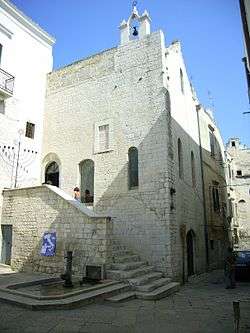 Scolanova Synagogue, Trani (1247)
Scolanova Synagogue, Trani (1247).jpg) Old New Synagogue, Prague (c. 1270)
Old New Synagogue, Prague (c. 1270) Main portal of the Old New Synagogue, Prague (c. 1270)
Main portal of the Old New Synagogue, Prague (c. 1270)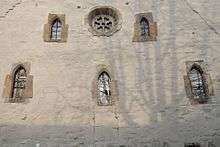 Old Synagogue, Erfurt (c. 1270)
Old Synagogue, Erfurt (c. 1270) Late Gothic vaulting of Pinkas Synagogue, Prague (1535)
Late Gothic vaulting of Pinkas Synagogue, Prague (1535)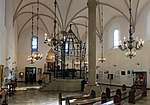 Renaissance interior of the Old Synagogue in Cracow using Gothic vaults (1570)
Renaissance interior of the Old Synagogue in Cracow using Gothic vaults (1570)
Although Christianity played a dominant role in the Gothic sacred architecture, Jewish communities were present in many European cities during the Middle Ages and they also built their houses of prayer in the Gothic style. Unfortunately, most of the Gothic synagogues did not survive, because they were often destroyed in connection with persecution of the Jews (e. g. in Bamberg, Nürnberg, Regensburg, Vienna). One of the best preserved examples of a Gothic synagogue is the Old New Synagogue in Prague which was completed around 1270 and never rebuilt.
Civic architecture

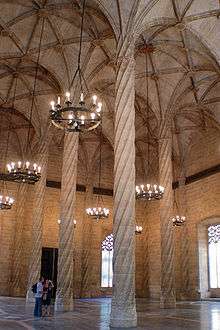
The Gothic style appeared in palaces in France, including the Papal Palace in Avignon and the Palais de la Cité in Paris, close to Notre-Dame de Paris, begun in 1119, which was the principal residence of the French Kings until 1417. Most of the Palais de la Cité is gone, but two of the original towers along the Seine, of the towers, the vaulted ceilings of the Hall of the Men-at-Arms (1302), (now in the Conciergerie; and the original chapel, Sainte-Chapelle, can still be seen.[101]
The largest civic building built in the Gothic style in France was the Palais des Papes (Palace of the Popes) constructed between 1252 and 1364, during the Avignon Papacy. Given the complicated political situation, it combined the functions of a church, a seat of government and a fortress. The Rouen Courthouse in Normandy is representative of Flamboyant Gothic in France.
In the 15th century, following the late Gothic period or flamboyant style, elements of Gothic decoration developed churches began to appear in the town halls of northern France, in Flanders and in the Netherlands. The Hôtel de Ville of Compiègne has an imposing Gothic bell tower, featuring a spire surrounded by smaller towers, and its windows are decorated with ornate accolades or ornamental arches. Similarly flamboyant town halls were found in Arras, Douai, and Saint-Quentin, Aisne, and in modern Belgium, in Brussels and Ghent and Bruges.[102]
Notable Gothic civil architecture in Spain includes the Silk Exchange in Valencia, Spain (1482–1548), a major marketplace, which features a main hall with twisting columns beneath its vaulted ceiling. Another Spanish Gothic landmark is the Palace of the Kings of Navarre in Olite (1269–1512), combining the features of a palace and a fortress.
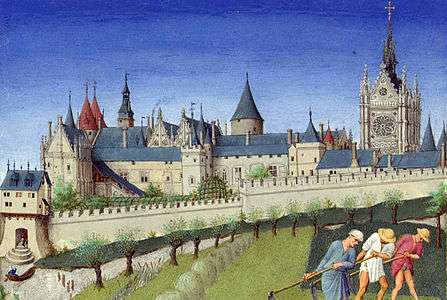 Palais de la Cité (1119–) and Sainte-Chapelle (1238–48), Paris, in 1412–16
Palais de la Cité (1119–) and Sainte-Chapelle (1238–48), Paris, in 1412–16- Hall of men-at-arms, Conciergerie, (1302) Paris
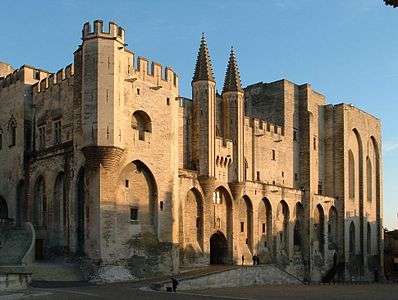 Façade of the Palais des Papes, Avignon (1252–1364)
Façade of the Palais des Papes, Avignon (1252–1364) The Doge's Palace, Venice (1340–1442)
The Doge's Palace, Venice (1340–1442) Silk Exchange, Valencia (1482–1548)
Silk Exchange, Valencia (1482–1548)- Palace of the Kings of Navarre, Olite (1269–1512)
 Gallery of Palau de la Generalitat, Barcelona(1403)
Gallery of Palau de la Generalitat, Barcelona(1403) Great Gatehouse at Hampton Court Palace, London (1522)
Great Gatehouse at Hampton Court Palace, London (1522)
University Gothic
The first universities in Europe were closely associated with the Catholic church, and in the late 15th century they adapted variations of the Gothic style for their architecture. The Gothic style was adapted from English monasteries for use in the first colleges of Oxford University, including Magdalen College. It was also used at the University of Salamanca in Spain. The use of the late Gothic style at Oxford and Cambridge University inspired the picturesque Gothic architecture in U.S. colleges in the 19th and 20th century.
By the late Middle Ages university towns had grown in wealth and importance as well, and this was reflected in the buildings of some of Europe's ancient universities. Particularly remarkable examples still standing nowadays include the Collegio di Spagna in the University of Bologna, built during the 14th and 15th centuries; the Collegium Carolinum of the Charles University in Prague in Bohemia; the Escuelas mayores of the University of Salamanca in Spain; the chapel of King's College, Cambridge; or the Collegium Maius of the Jagiellonian University in Kraków, Poland.
- Gothic oriel window, Karolinum, Charles University, Prague (c.1380)
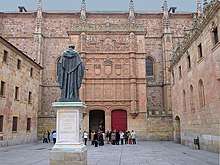 Plateresque façade, University of Salamanca (late 15th century)
Plateresque façade, University of Salamanca (late 15th century)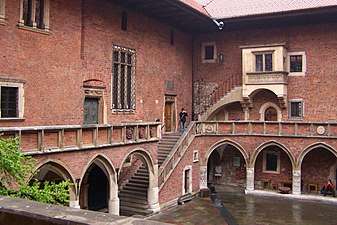 Cloister, Collegium Maius, Kraków (late 15th century)
Cloister, Collegium Maius, Kraków (late 15th century)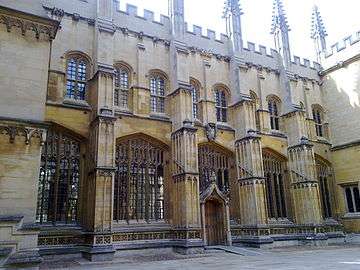 Divinity School, Oxford (1427–1483)
Divinity School, Oxford (1427–1483)- Old Court, Queens' College, Cambridge (1448–51)
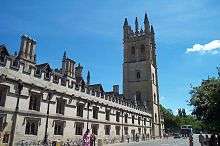 Tower and cloisters of Magdalen College, Oxford (1474–1480)
Tower and cloisters of Magdalen College, Oxford (1474–1480).jpg) Chapel of King's College, Aberdeen (1498–1509)
Chapel of King's College, Aberdeen (1498–1509) Staircase to the Great Hall, Christ Church, Oxford (c.1640)
Staircase to the Great Hall, Christ Church, Oxford (c.1640)
Military architecture
In the 13th century, the design of the castle (French: château fort) evolved in response to contact with the more sophisticated fortifications of the Byzantine Empire and the Islamic world during the Crusades. These new fortifications were more geometric, with a central high tower called a keep (French: donjon) which could be defended even if the curtain walls of the castle were breached. The donjon of the Château de Vincennes, begun by Philip VI of France, was a good example. It was 52 meters high, the tallest military tower in Europe. A new kind of fortification was called Phillipienne after the crusading king Philip II of France.
Towers, usually round, were placed at the corners and along the walls in the Phillipienne castle, close enough together to support each other. The walls had two levels of walkways on the inside, a crennellated parapet with merlons, and projecting machicolations from which missiles could be dropped on besiegers. The upper walls also had protected protruding balconies, échauguettes and bretèches, from which soldiers could see what was happening at the corners or on the ground below. In addition, the towers and walls were pierced with arrowslits, which sometimes took the form of crosses to enable a wider field of fire for archers and crossbowmen.[103]
Castles were surrounded by a deep moat, spanned by a single drawbridge. The entrance was also protected by a grill of iron which could be opened and closed. The walls at the bottom were often sloping, and protected with earthen barriers. One good surviving example is the Château de Dourdan, near Nemours.[104]
After the end of the Hundred Years War (1337–1453), with improvements in artillery, the castles lost most of their military importance. They remained as symbols of the rank of their noble occupants; the narrowing openings in the walls were often widened into the windows of bedchambers and ceremonial halls. The tower of the Château de Vincennes became a royal residence.[104]
 Donjon of the Château de Vincennes, begun 1337
Donjon of the Château de Vincennes, begun 1337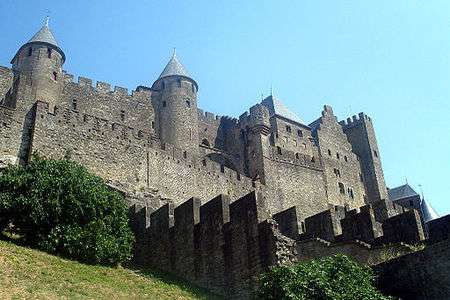 Restored outer walls of the medieval city of Carcassonne (13th–14th century)
Restored outer walls of the medieval city of Carcassonne (13th–14th century)- Malbork Castle in Poland (13th century)
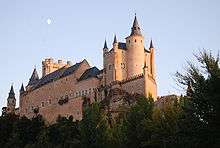 Alcazar of Segovia (12th–13th centuries)
Alcazar of Segovia (12th–13th centuries)- Hohenzollern Castle (1454–1461) in Baden-Württemberg, southern Germany
 The Louvre in the time of Charles V of France (1338–1380) drawn by Eugene Viollet-le-Duc
The Louvre in the time of Charles V of France (1338–1380) drawn by Eugene Viollet-le-Duc
Decline
Beginning in the 16th century, as Renaissance architecture from Italy began to appear in France and other countries in Europe, the dominance of Gothic architecture began to wane. Nonetheless, new Gothic buildings, particularly churches, continued to be built.
New Gothic churches built in Paris in this period included Saint-Merri (1520–1552) and Saint-Germain l'Auxerrois. The first signs of classicism in Paris churches did not appear until 1540, at Saint-Gervais-Saint-Protais. The largest new church, Saint-Eustache (1532–1560), rivalled Notre-Dame in size, 105 meters long, 44 meters wide, and 35 meters high. As construction of this church continued, elements of Renaissance decoration, including the system of classical orders of columns, were added to the design, making it an early Gothic-Renaissance hybrid.[105]
The Gothic style began to be described as outdated, ugly and even barbaric. The term "Gothic" was first used as a pejorative description. Giorgio Vasari used the term "barbarous German style" in his 1550 Lives of the Artists to describe what is now considered the Gothic style.[106] In the introduction to the Lives he attributed various architectural features to the Goths whom he held responsible for destroying the ancient buildings after they conquered Rome, and erecting new ones in this style.[107] In the 17th century, Molière also mocked the Gothic style in the 1669 poem La Gloire: "...the insipid taste of Gothic ornamentation, these odious monstrosities of an ignorant age, produced by the torrents of barbarism..."[108] The dominant styles in Europe became in turn Italian Renaissance architecture, Baroque architecture, and the grand classicism of the style Louis XIV.
Survival, rediscovery and revival
_-_The_Thistle_Chapel.jpg)
Gothic architecture, usually churches or university buildings, continued to be built. Ireland was an island of Gothic architecture in the 17th and 18th centuries, with the construction of Derry Cathedral (completed 1633), Sligo Cathedral (c. 1730), and Down Cathedral (1790–1818) are other notable examples.[109] In the 17th and 18th century several important Gothic buildings were constructed at Oxford University and Cambridge University, including Tom Tower (1681–82) at Christ Church, Oxford, by Christopher Wren. It also appeared, in a whimsical fashion, in Horace Walpole's Twickenham villa, Strawberry Hill (1749–1776). The two western towers of Westminster Abbey were constructed between 1722 and 1745 by Nicholas Hawksmoor, opening a new period of Gothic Revival.
In England, partly in response to a philosophy propounded by the Oxford Movement and others associated with the emerging revival of 'high church' or Anglo-Catholic ideas during the second quarter of the 19th century, neo-Gothic began to become promoted by influential establishment figures as the preferred style for ecclesiastical, civic and institutional architecture. The appeal of this Gothic revival (which after 1837, in Britain, is sometimes termed Victorian Gothic), gradually widened to encompass "low church" as well as "high church" clients. This period of more universal appeal, spanning 1855–1885, is known in Britain as High Victorian Gothic.
The Palace of Westminster in London by Sir Charles Barry with interiors by a major exponent of the early Gothic Revival, Augustus Welby Pugin, is an example of the Gothic revival style from its earlier period in the second quarter of the 19th century. Examples from the High Victorian Gothic period include George Gilbert Scott's design for the Albert Memorial in London, and William Butterfield's chapel at Keble College, Oxford. From the second half of the 19th century onwards, it became more common in Britain for neo-Gothic to be used in the design of non-ecclesiastical and non-governmental buildings types. Gothic details even began to appear in working-class housing schemes subsidised by philanthropy, though given the expense, less frequently than in the design of upper and middle-class housing.
The middle of the 19th century was a period marked by the restoration, and in some cases modification, of ancient monuments and the construction of neo-Gothic edifices such as the nave of Cologne Cathedral and the Sainte-Clotilde of Paris as speculation of mediaeval architecture turned to technical consideration. London's Palace of Westminster, St Pancras railway station, New York's Trinity Church and St Patrick's Cathedral are also famous examples of Gothic Revival buildings.[110] The style also reached the Far East in the period, for instance, the Anglican St. John's Cathedral which was located at the centre of Victoria City in Central, Hong Kong.
 Tom Tower, Christ Church, Oxford, (1681–82), designed by Christopher Wren.
Tom Tower, Christ Church, Oxford, (1681–82), designed by Christopher Wren.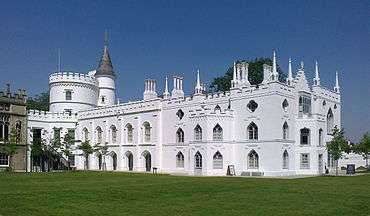 Strawberry Hill House, Twickenham (begun 1749, completed in 1776), designed for Horace Walpole.
Strawberry Hill House, Twickenham (begun 1749, completed in 1776), designed for Horace Walpole.- Guildhall, London, main entrance (completed 1788) designed by George Dance
 Elizabeth Tower (Big Ben) (completed in 1859) and the Houses of Parliament in London (1840–1876)
Elizabeth Tower (Big Ben) (completed in 1859) and the Houses of Parliament in London (1840–1876)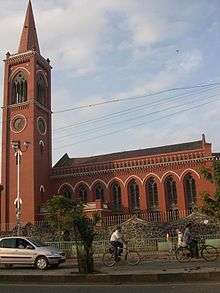 Ohel David Synagogue, Pune (completed 1867)
Ohel David Synagogue, Pune (completed 1867)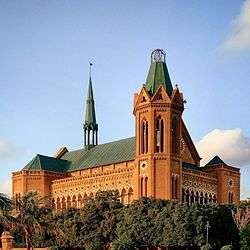 Frere Hall, Karachi, (completed 1865)
Frere Hall, Karachi, (completed 1865) St. Patrick's Cathedral, New York City, (completed 1878)
St. Patrick's Cathedral, New York City, (completed 1878) Palazzo del Governatore, Rhodes (1927) designed by Florestano Di Fausto
Palazzo del Governatore, Rhodes (1927) designed by Florestano Di Fausto
See also
Mediaeval Gothic
- Belarusian Gothic
- Brabantine Gothic
- Catalan Gothic
- Czech Gothic architecture
- English Gothic architecture
- French Gothic architecture
- Gothic architecture in Lithuania
- Gothic cathedrals and churches
- Gothic secular and domestic architecture
- Italian Gothic architecture
- List of Gothic architecture
- Polish Gothic architecture
- Portuguese Gothic architecture
- Romano-Gothic
- Southern French Gothic
- Spanish Gothic architecture
- Valencian Gothic
- Venetian Gothic architecture
Gothic architecture
- Architectural history
- Architecture of cathedrals and great churches
- Carpenter Gothic
- Collegiate Gothic in North America
- Gothicmed
- Sondergotik
- Tented roof
Notes
- "Gotz" is rendered as "Huns" in Thomas Urquhart's English translation.
- While the engineering and construction of the dome of Florence Cathedral by Brunelleschi is often cited as one of the first works of the Renaissance, the octagonal plan, ribs and pointed silhouette were already determined in the 14th century.
- The Gothic south tower is surmounted by a Baroque spire.
Citations
- Curl, James Stevens; Wilson, Susan, eds. (2015), "Gothic", A Dictionary of Architecture and Landscape Architecture (3rd ed.), Oxford University Press, doi:10.1093/acref/9780199674985.001.0001, ISBN 978-0-19-967498-5, retrieved 9 April 2020
- Schurr, Marc Carel (2010), Bork, Robert E. (ed.), "art and architecture: Gothic", The Oxford Dictionary of the Middle Ages, Oxford University Press, doi:10.1093/acref/9780198662624.001.0001, ISBN 978-0-19-866262-4, retrieved 9 April 2020
- Fraser, Murray, ed. (2018), Sir Banister Fletcher Glossary (21st ed.), Royal Institute of British Architects (RIBA) and the University of London, doi:10.5040/9781350122741.1001019, ISBN 978-1-350-12274-1, retrieved 18 May 2020 Missing or empty
|title=(help);|chapter=ignored (help) - Moffett, Fazio and Wodehouse, p.230
- Mignon 2015, pp. 8–9.
- Curl, James Stevens; Wilson, Susan, eds. (2015), "Gothic", A Dictionary of Architecture and Landscape Architecture (3rd ed.), Oxford University Press, doi:10.1093/acref/9780199674985.001.0001, ISBN 978-0-19-967498-5, retrieved 9 April 2020
- Curl, James Stevens; Wilson, Susan, eds. (2015), "ogive", A Dictionary of Architecture and Landscape Architecture (3rd ed.), Oxford University Press, doi:10.1093/acref/9780199674985.001.0001, ISBN 978-0-19-967498-5, retrieved 9 April 2020
- Bogdanović, Jelena (2010), Bjork, Robert E. (ed.), "opus Francigenum", The Oxford Dictionary of the Middle Ages, Oxford University Press, doi:10.1093/acref/9780198662624.001.0001, ISBN 978-0-19-866262-4, retrieved 9 April 2020
- Bannister Fletcher, p.524
- Vasari, G. The Lives of the Artists. Translated with an introduction and notes by J.C. and P. Bondanella. Oxford: Oxford University Press (Oxford World’s Classics), 1991, pp. 117 & 527. ISBN 9780199537198
- Vasari, Giorgio. (1907) Vasari on technique: being the introduction to the three arts of design, architecture, sculpture and painting, prefixed to the Lives of the most excellent painters, sculptors and architects. G. Baldwin Brown Ed. Louisa S. Maclehose Trans. London: Dent, pp. b & 83.
- "Gothic Architecture - Loyola's Historic Architecture - Department of History - Loyola University Maryland". www.loyola.edu. Retrieved 24 May 2020.
- Bolton, A. T., ed. (1925). "St Paul's Cathedral". The Wren Society. Oxford University Press. II: 15–20.
- Notes and Queries, No. 9. 29 December 1849
- Gothique. Encyclopédie Larousse (in French) (online ed.). Retrieved 15 May 2020.
- Encylopaedia Britannica on-line, "Gothic art- architecture" (retrieved May 15, 2020)
- Mignon 2015, pp. 10–11.
- Le Guide du Patrimoine de France (2002) pg. 53
- Schurr, Marc Carel (2010), Bork, Robert E. (ed.), "art and architecture: Gothic", The Oxford Dictionary of the Middle Ages, Oxford University Press, doi:10.1093/acref/9780198662624.001.0001, ISBN 978-0-19-866262-4, retrieved 9 April 2020
- Renault & Lazé 2006, p. 36.
- Mignon 2015, p. 30.
- Mignon 2015, pp. 30-31.
- Cited in Bechmann, "Les Racines des Cathedrals (2011), pg. 188
- Mignon 2015, p. 10.
- Curl, James Stevens; Wilson, Susan, eds. (2015), "Sens, William of", A Dictionary of Architecture and Landscape Architecture (3rd ed.), Oxford University Press, doi:10.1093/acref/9780199674985.001.0001, ISBN 978-0-19-967498-5, retrieved 10 April 2020
- "William of Sens | French architect". Encyclopedia Britannica. Retrieved 15 May 2020.
- Curl, James Stevens; Wilson, Susan, eds. (2015), "Perpendicular", A Dictionary of Architecture and Landscape Architecture (3rd ed.), Oxford University Press, doi:10.1093/acref/9780199674985.001.0001, ISBN 978-0-19-967498-5, retrieved 16 May 2020
- Curl, James Stevens; Wilson, Susan, eds. (2015), "Ely, Reginald", A Dictionary of Architecture and Landscape Architecture, Oxford University Press, doi:10.1093/acref/9780199674985.001.0001, ISBN 978-0-19-967498-5, retrieved 16 May 2020
- Curl, James Stevens; Wilson, Susan, eds. (21 May 2015), "Vertue, Robert", A Dictionary of Architecture and Landscape Architecture, Oxford University Press, doi:10.1093/acref/9780199674985.001.0001, ISBN 978-0-19-967498-5, retrieved 16 May 2020
- "L'art Gothique", section: "L'architecture Gothique en Angleterre" by Ute Engel: L'Angleterre fut l'une des premieres régions à adopter, dans la deuxième moitié du XIIeme siècle, la nouvelle architecture gothique née en France. Les relations historiques entre les deux pays jouèrent un rôle prépondérant: en 1154, Henri II (1154–1189), de la dynastie Française des Plantagenêt, accéda au thrône d'Angleterre." (England was one of the first regions to adopt, during the first half of the 12th century, the new Gothic architecture born in France. Historic relationships between the two countries played a determining role: in 1154, Henry II (1154–1189) became the first of the Anjou Plantagenet kings to ascend to the throne of England).
- Banister Fletcher, A History of Architecture on the Comparative Method.
- John Harvey, The Gothic World
- Grodecki 1977, p. 28.
- Grodecki 1977, pp. 29–30.
- Grodecki 1977, p. 30.
- Alec Clifton-Taylor, The Cathedrals of England
- Robert Liddiard, Anglo-Norman Castles (Woodbridge, Suffolk: Boydell, 2003). ISBN 0851159044; and Kenneth John Conant, Carolingian and Romanesque Architecture, 800 to 1200 (NY: Penguin, 1959; reprint, New Haven CT: Yale University Press, 1993). ISBN 0300052987
- Maximilian Sternberg, Cistercian Architecture and Medieval Society (Leiden: Brill, 2013), 132–50. ISBN 9004251812; Eric Fernie, The Architecture of Norman England (Oxford University Press, 2000), 4–20 and 50. ISBN 0199250812; and Ann Williams, "A bell-house and a burh-geat: lordly residences in England before the Norman Conquest", Medieval Knighthood 4 (1992): 221–40.
- Nikolaus Pevsner, An Outline of European Architecture.
- Draper 2005, p. 1–20.
- Warren, John (1991). "Creswell's Use of the Theory of Dating by the Acuteness of the Pointed Arches in Early Muslim Architecture". Muqarnas. BRILL. 8: 59–65, 61–63. doi:10.2307/1523154. JSTOR 1523154.
- Draper 2005, p. 3–4.
- Draper 2005, p. 4.
- Draper 2005, p. 8.
- Draper 2005, p. 12.
- Draper 2005, p. 15.
- Scott, Robert A.: The Gothic enterprise: a guide to understanding the Medieval cathedral, Berkeley 2003, University of California Press, p. 113 ISBN 0-520-23177-5
- Cf. Bony (1983), especially p.17
- Draper 2005, p. 17–18.
- "Cluny Abbey (article) | Romanesque". Khan Academy. Retrieved 7 May 2020.
- François Salet, « L'église abbatiale de Lessay », Bulletin monumental, vol. 1117, no 1, 1959, p. 56-59
- "The notable exception is Durham Cathedral, the nave and choir of which (c. 1104) are supported by the first known examples of pointed ribbed vaults." Encyclopaedia Britannica on-line, "Norman Architecture" (retrieved 7 May 2020)
- Le genie architectural des Normands a su s’adapter aux lieux en prenant ce qu’il y a de meilleur dans le savoir-faire des batisseurs arabes et byzantins", Les Normands en Sicile, pp.14, 53–57.
- Harvey, L. P. (1992). "Islamic Spain, 1250 to 1500". Chicago : University of Chicago Press. ISBN 0-226-31960-1; Boswell, John (1978). Royal Treasure: Muslim Communities Under the Crown of Aragon in the Fourteenth Century. Yale University Press. ISBN 0-300-02090-2.
- Warren, John (1991). "Creswell's Use of the Theory of Dating by the Acuteness of the Pointed Arches in Early Muslim Architecture". Muqarnas. BRILL. 8: 59–65. doi:10.2307/1523154. JSTOR 1523154.
- Encylopédie Larousse, L'Architecture Gothique (retrieved May 24, 2020)
- "Architectural Importance". Durham World Heritage Site. Retrieved 26 March 2013.
- "lancet". Oxford English Dictionary Online. Retrieved 25 May 2020.
- Sir Banister Fletcher Glossary, © the Royal Institute of British Architects (RIBA) and the University of London, 2018, doi:10.5040/9781350122741.1001308, ISBN 978-1-350-12274-1, retrieved 25 May 2020,
Gothic arch or window rising to a point at its apex.
Missing or empty|title=(help);|chapter=ignored (help) - Curl, James Stevens; Wilson, Susan, eds. (2015), "Lancet style", A Dictionary of Architecture and Landscape Architecture (3rd ed.), Oxford University Press, doi:10.1093/acref/9780198606789.001.0001, ISBN 978-0-19-967498-5, retrieved 9 April 2020,
First Pointed Gothic of the late C12 before the introduction of tracery.
- Renault & Lazé 2006, p. 37.
- Ducher 1988, p. 46.
- Bechmann 2017, pp. 183–185.
- Renault & Lazé 2006, p. 35.
- Mignon 2015, pp. 18–28.
- Encylopaedia Britannica on-line, "Western architecture- Gothic" (retrieved May 22, 2020)
- Ducher 1988, pp. 50–51.
- Encylopaedia Britannica on-line, "William of Sens",
- Enclopaedia Britannica on-line, "Spires" (retrieved 14 May 2020)
- Wenzler 2018, pp. 95–98.
- Trintignac and Coloni, Decouvrir Notre-Dame de Paris (1984), (in French), les Editions du Cerf, ISBN 2-204-02087-7, pp. 259-260
- Mignon 2015, p. 21.
- Julian Flannery, Fifty English Steeples: The Finest Medieval Parish Church Towers and Spires in England, T&H, 2016, 10-0500343144
- "Explore Reims Cathedral, a Historic Monument!". French Moments. 19 November 2012. Retrieved 3 June 2020.
- Rodwell, Warwick (2010). The Lantern Tower of Westminster Abbey, 1060-2010: Reconstructing its History and Architecture. Havertown: Oxbow Books. ISBN 978-1-84217-761-7. OCLC 841909231.
- Curl, James Stevens; Wilson, Susan, eds. (2015), "tracery", A Dictionary of Architecture and Landscape Architecture (3rd ed.), Oxford University Press, doi:10.1093/acref/9780199674985.001.0001, ISBN 978-0-19-967498-5, retrieved 26 May 2020
- Ecyclopaedia Britannica on-line, "Tracery" (retrieved May 26, 2020)
- "tracery | Definition & Facts". Encyclopedia Britannica. Retrieved 26 May 2020.
- Cannon, J. 2007. Cathedral: The Great English Cathedrals and the World that Made Them
- "Gothic architecture | Characteristics, Examples, & Facts". Encyclopedia Britannica. Retrieved 29 May 2020.
- Wim Swaan, The Gothic Cathedral
- Grodecki 1977, pp. 14, 17.
- https://chartrescathedral.net//chartres-cathedral-royal-portal-sculpture/.
- Wenzler 2018, p. 79.
- Wenzler 2018, p. 54.
- The open-work spire was completed in 1890 to the original design.
- Watkin 1986, p. 128.
- Banister Fletcher, 17th edition, p. 534
- James, Sara N. (31 October 2016). Art in England: The Saxons to the Tudors: 600-1600. Oxbow Books. ISBN 978-1-78570-226-6.
- Thomas Rickman, Attempt to Discriminate the Style of Architecture in England (1812–15)
- "Rayonnant style". Encyclopaedia Britannica. 4 April 2016.
- Grodecki 1977, p. 20.
- Mignon 2015, p. 9.
- Mignon 2015, p. 22.
- Wenzler 2018, p. 28.
- Viollet-le-Duc, Eugéne, Dictionnaire Raisonné de l'architecture Française du XIe au XVI siecle, Volume 6. (Project Gutenburg).
- McNamara 2017, pp. 158–59.
- Frazer, James George (1933) ed., Ovid, Fasti VI. 131–,Riley (1851), p. 216, tr.
- Wenzler 2018, pp. 97–99.
- Wenzler 2018, pp. 99–100.
- Texier 2012, p. 12.
- Ducher 1988, p. 64.
- Ducher 1988, pp. 66–67.
- Renault & Lazé 2006, p. 38.
- Texier 2012, pp. 24–26.
- Vasari 1991, pp. 117, 527.
- Vasari, Brown & Maclehose 1907, p. 83.
- Grodecki 1977, p. 9.
- Hunter, Bob (18 September 2014). "Londonderry Cathedtral". Wars & Conflict: The Plantation of Ulster. BBC.
- "Gothic Architecture and Churches | Architectural Digest". Architectural Digest. Retrieved 18 July 2017.
Bibliography
- Bechmann, Roland (2017). Les Racines des Cathédrales (in French). Payot. ISBN 978-2-228-90651-7.CS1 maint: ref=harv (link)
- Burton, Janet B.; Kerr, Julie (2011). The Cistercians in the Middle Ages. Monastic orders. Volume 4 (Illustrated ed.). Boydell Press. ISBN 9781843836674.CS1 maint: ref=harv (link)
- Bony, Jean (1983). French Gothic Architecture of the Twelfth and Thirteenth Centuries. University of California Press. ISBN 978-0-520-02831-9.CS1 maint: ref=harv (link)
- Ching, Francis D.K. (2012). A Visual Dictionary of Architecture (2nd ed.). John Wiley & Sons, Inc. ISBN 978-0-470-64885-8.CS1 maint: ref=harv (link)
- Der Manuelian, Lucy (2001). "Ani: The Fabled Capital of Armenia". In Cowe, S. Peter (ed.). Ani: World Architectural Heritage of a Medieval Armenian Capital. Leuven Sterling. ISBN 978-90-429-1038-6.CS1 maint: ref=harv (link)
- Draper, Peter (2005). "Islam and the West: The Early Use of the Pointed Arch Revisited". Architectural History. 5. doi:10.1017/S0066622X00003701. ISSN 0066-622X. JSTOR 40033831.
- Ducher, Robert (1988). Caractéristique des Styles (in French). Flammarion. ISBN 978-2-08-011539-3.CS1 maint: ref=harv (link)
- Fiske, Kimball (1943). The Creation of the Rococo. Philadelphia Museum of Art.CS1 maint: ref=harv (link)
- Fletcher, Banister (2001). A History of Architecture on the Comparative Method. Elsevier Science & Technology. ISBN 978-0-7506-2267-7.CS1 maint: ref=harv (link)
- Garsoïan, Nina G. (2015). "Sirarpie Der Nersessian (1896–1989)". In Damico, Helen (ed.). Medieval Scholarship: Biographical Studies on the Formation of a Discipline: Religion and Art. Routledge. ISBN 978-1-317-77636-9.CS1 maint: ref=harv (link)
- Giese, Francine; Pawlak, Anna; Thome, Markus (2018). Tomb – Memory – Space: Concepts of Representation in Premodern Christian and Islamic Art (in German). Walter de Gruyter GmbH & Co KG. ISBN 9783110517347.CS1 maint: ref=harv (link)
- Grodecki, Louis (1977). Nervi, Luigi (ed.). Gothic Architecture. In collaboration with Anne Prache and Roland Recht, translated from French by I. Mark Paris. Abrams Books. ISBN 978-0-8109-1008-9.CS1 maint: ref=harv (link)
- Harvey, John (1950). The Gothic World, 1100–1600. Batsford. ISBN 978-0-00-255228-8.CS1 maint: ref=harv (link)
- Hughes, William; Punter, David; Smith, Andrew (2015). The Encyclopedia of the Gothic. John Wiley & Sons. ISBN 9781119210412.CS1 maint: ref=harv (link)
- Jones, Colin (1999). The Cambridge Illustrated History of France. Cambridge University Press. ISBN 978-0-521-66992-4.CS1 maint: ref=harv (link)
- Lang, David Marshall (1980). Armenia: Cradle of Civilization. Allen & Unwin.CS1 maint: ref=harv (link)
- Martindale, Andrew (1993). Gothic Art. Thames and Hudson. ISBN 978-2-87811-058-6.CS1 maint: ref=harv (link)
- McNamara, Denis (2017). Comprendre l'Art des Églises (in French). Larousse. ISBN 978-2-03-589952-1.CS1 maint: ref=harv (link)
- Mignon, Olivier (2017). Architecture du Patrimoine Française - Abbayes, Églises, Cathédrales et Châteaux (in French). Éditions Ouest-France. ISBN 978-27373-7611-5.CS1 maint: ref=harv (link)
- Mignon, Olivier (2015). Architecture des Cathédrales Gothiques (in French). Éditions Ouest-France. ISBN 978-2-7373-6535-5.CS1 maint: ref=harv (link)
- Mitchell, Ann (1968). Cathedrals of Europe. Great Buildings of the World. Hamlyn. ASIN B0006C19ES.CS1 maint: ref=harv (link)
- Moffat, Fazio & Wodehouse (2003). A World History of Architecture. Laurence King Publishing. ISBN 1-85669-353-8.CS1 maint: ref=harv (link)
- Oggins, R.O. (2000). Cathedrals. Metrobooks. Friedman/Fairfax Publishers. ISBN 9781567993462. Retrieved 6 October 2010.CS1 maint: ref=harv (link)
- Pevsner, Nikolaus (1964). An Outline of European Architecture. Pelican Books. ISBN 978-0-14-061613-2.CS1 maint: ref=harv (link)
- Poisson, Georges; Poisson, Olivier (2014). Eugène Viollet-le-Duc (in French). Paris: Picard. ISBN 978-2-7084-0952-1.
- Raeburn, Michael (1980). "The Middle Ages". In Coldstream, Nicola (ed.). Architecture of the Western World. With a foreword by Sir Hugh Casson. Rizzoli International. ISBN 978-0-8478-0349-1.CS1 maint: ref=harv (link)
- Renault, Christophe; Lazé, Christophe (2006). Les Styles de l'architecture et du mobilier (in French). Gisserot. ISBN 978-2-87747-465-8.CS1 maint: ref=harv (link)
- Scott, Robert A. (2003). The Gothic enterprise: a guide to understanding the Medieval cathedral. University of California Press. ISBN 978-0-520-23177-1.CS1 maint: ref=harv (link)
- Stewart, Cecil (1959). History of Architectural Development: Early Christian, Byzantine and Romanesque Architecture. Longman.CS1 maint: ref=harv (link)
- Swaan, Wim (1988). The Gothic Cathedral. Omega Books. ISBN 978-0-907853-48-0.CS1 maint: ref=harv (link)
- Rice, David Talbot (1972). The Appreciation of Byzantine Art. Oxford University Press.CS1 maint: ref=harv (link)
- Texier, Simon (2012). Paris Panorama de l'architecture de l'Antiquité à nos jours (in French). Parigramme. ISBN 978-2-84096-667-8.CS1 maint: ref=harv (link)
- Toman, Rolf (2007). Néoclassicisme et Romantisme. Ulmann. ISBN 978-3-8331-3557-6.CS1 maint: ref=harv (link)
- Vasari, Giorgio (1907). Brown, Gerald Baldwin; Maclehose, Louisa (eds.). Vasari on Technique: Being the Introduction to the Three Arts of Design, Architecture, Sculpture and Painting, Prefixed to the Lives of the Most Excellent Painters, Sculptors and Architects. J. M. Dent & Co.CS1 maint: ref=harv (link)
- Vasari, Giorgio (1991). The Lives of the Artists. Translated with an introduction and notes by J.C. and P. Bondanella. Oxford University Press. ISBN 978-0-19-953719-8.CS1 maint: ref=harv (link)
- Watkin, David (1986). A History of Western Architecture. Barrie and Jenkins. ISBN 0-7126-1279-3.
- Wenzler, Claude (2018). Les cathédrales gothiques: Un défi médiéval (in French). Éditions Ouest-France. ISBN 978-2-7373-7712-9.CS1 maint: ref=harv (link)
- "Chartres Cathedral Royal Portal Sculpture". Chartres Cathedral. Chartres Cathedral. 2020. Retrieved 31 May 2020.
Further reading
- Buttitta, Antonino, ed. (2006). Les Normands en Sicile. Musée de Normandie. ISBN 978-88-7439-328-2.
- Fletcher, Banister; Cruickshank, Dan, Sir Banister Fletcher's a History of Architecture, Architectural Press, 20th edition, 1996 (first published 1896). ISBN 0-7506-2267-9. Cf. Part Two, Chapter 14.
- Bumpus, T. Francis (1928). The Cathedrals and Churches of Belgium. T. Werner Laurie. ISBN 978-1-313-40185-2.
- Clifton-Taylor, Alec (1967). The Cathedrals of England. Thames and Hudson. ISBN 978-0-500-18070-9.
- Gardner, Helen; Kleiner, Fred S.; Mamiya, Christin J. (2004). Gardner's Art Through the Ages. Thomson Wadsworth. ISBN 978-0-15-505090-7.
- Harvey, John (1961). English Cathedrals. Batsford. ASIN B0000CL4S8.
- Huyghe, René, ed. (1963). Larousse Encyclopedia of Byzantine and Medieval Art. Hamlyn. ISBN 978-0-600-02357-9.
- Icher, Francois (1998). Building the Great Cathedrals. Abrams Books. ISBN 978-0-8109-4017-8.
- Simson, Otto Georg (1988). The Gothic cathedral: origins of Gothic architecture and the medieval concept of order. ISBN 978-0-691-09959-0.
- Glaser, Stephanie, "The Gothic Cathedral and Medievalism," in: Falling into Medievalism, ed. Anne Lair and Richard Utz. Special Issue of UNIversitas: The University of Northern Iowa Journal of Research, Scholarship, and Creative Activity, 2.1 (2006). (on the Gothic revival of the 19th century and the depictions of Gothic cathedrals in the Arts)
- Moore, Charles (1890). Development & Character of Gothic Architecture. Macmillan and Co. ISBN 978-1-4102-0763-0.
- Rudolph, Conrad ed., A Companion to Medieval Art: Romanesque and Gothic in Northern Europe, 2nd ed. (2016)
- Tonazzi, Pascal (2007) Florilège de Notre-Dame de Paris (anthologie), Editions Arléa, Paris, ISBN 2-86959-795-9
- Wilson, Christopher (2005). The Gothic Cathedral – Architecture of the Great Church. Thames and Hudson. ISBN 978-0-500-27681-5.
- Summerson, John (1983). Pelican Books (ed.). Architecture in Britain, 1530–1830. ISBN 978-0-14-056003-9.
- Swaan, Wim. Art and Architecture of the Late Middle Ages. Omega Books. ISBN 978-0-907853-35-0.
- Tatton-Brown, Tim; Crook, John (2002). The English Cathedral. New Holland Publishers. ISBN 978-1-84330-120-2.
- Ceccarini, Patrizio (2013). La structure fondatrice gothique. Théologie, sciences et architecture au XIIIe siècle à Saint-Denis (tomeI). I. ISBN 978-2-336-30184-6.
- Ceccarini, Patrizio (2013). Le système architectural gothique. Théologie, sciences et architecture au XIIIe siècle à Saint-Denis. II. ISBN 978-2-336-30185-3.
- Rivière, Rémi; Lavoye, Agnès (2007). La Tour Jean sans Peur, Association des Amis de la tour Jean sans Peur. ISBN 978-2-95164-940-8
External links
| Library resources about Gothic architecture |
| Wikimedia Commons has media related to Gothic architecture. |
| Wikivoyage has a travel guide for Gothic architecture. |
| Wikisource has the text of the 1911 Encyclopædia Britannica article Gothic. |
- Mapping Gothic France, a project by Columbia University and Vassar College with a database of images, 360° panoramas, texts, charts and historical maps
- Gothic Architecture Encyclopædia Britannica
- Holbeche Bloxam, Matthew (1841). Gothic Ecclesiastical Architecture, Elucidated by Question and Answer. Gutenberg.org, from Project Gutenberg
- Brandon, Raphael; Brandon, Arthur (1849). An analysis of Gothick architecture: illustrated by a series of upwards of seven hundred examples of doorways, windows, etc., and accompanied with remarks on the several details of an ecclesiastical edifice. Archive.org, from Internet Archive
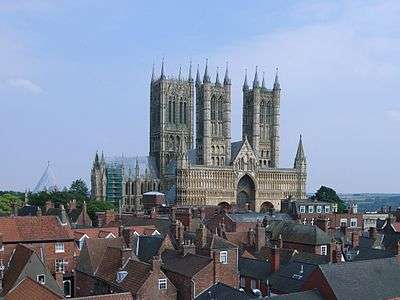

.jpg)

